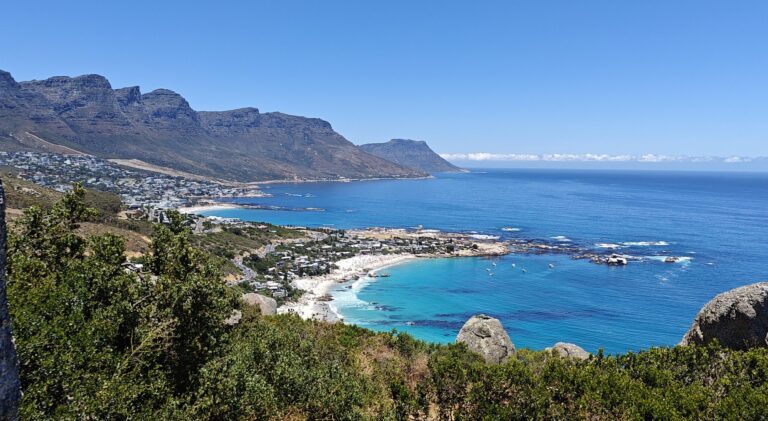Marrakesh Itinerary: Everything to See, Skip, and Savor
After years of slow traveling through vineyards in New Zealand, beach towns in Italy and diverse scenery of North America, Marrakesh still managed to take us by surprise. In the best, most fragrant, and occasionally overwhelming way. That’s what inspires us to share the perfect Marrakesh itinerary for your trip.
We spent a few weeks here, working remote mornings from the rooftop of our riad (mint tea in hand) and wandering through the maze of the Medina in the afternoons. It’s one of those cities where your Google Maps app will give up on you, and that’s part of the charm. Getting lost is basically a rite of passage.
The chaos is real, but so is the calm – tucked inside courtyards filled with orange trees, or in the hammams where time slows to a trickle. Marrakesh is all contrast: ancient and modern, wild and serene, deeply local yet completely global. It’s not everyone’s vibe, but if you’re curious, open to culture shock and mildly obsessed with olives, carpets, or architecture, this city will reward you.
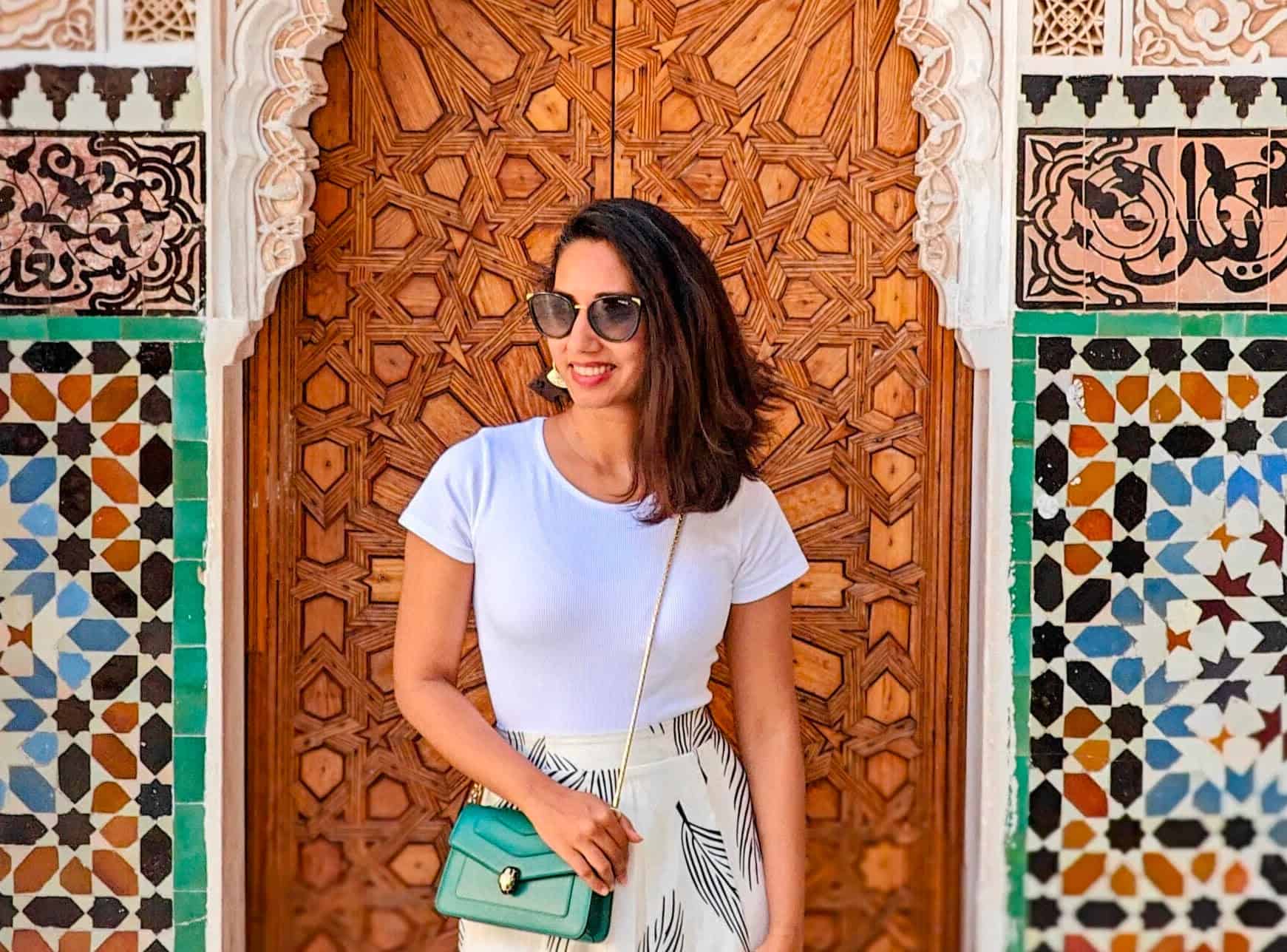
Who This Marrakesh Itinerary Is For
This isn’t your classic “checklist in 48 hours” kind of Marrakesh itinerary. It’s for people who travel with intention. Couples like us who work remotely and like to soak in the rhythm of a place, not just rush through it. If you’re the kind of traveler who values local food, slow mornings, wandering without plans and seeking out moments that don’t always make it to Instagram – welcome, you’re our kind of people!
We’ve broken this Marrakesh itinerary into a flexible 3-5 day plan, based on what we actually did (plus a few things we wish we’d done earlier). You can mix and match depending on your vibe, energy, and how many tagines you can realistically consume in a single day.
Best Time to Visit Marrakesh
March-May or September-November = Goldilocks Zone
December-February = Chill, calm, fewer crowds
June-August = Budget-friendly but heat-intense
Let’s get one thing out of the way: Marrakesh can get hot. Like, open-a-tagine-and-get-steamed-instantly hot. But the truth is, if you time it right, the city can be surprisingly pleasant. Even for long stays like ours.
We were based there in early spring, and it struck the perfect balance. Warm enough for rooftop dinners, cool enough for daytime wandering and minimal crowds clogging up every photogenic doorway.
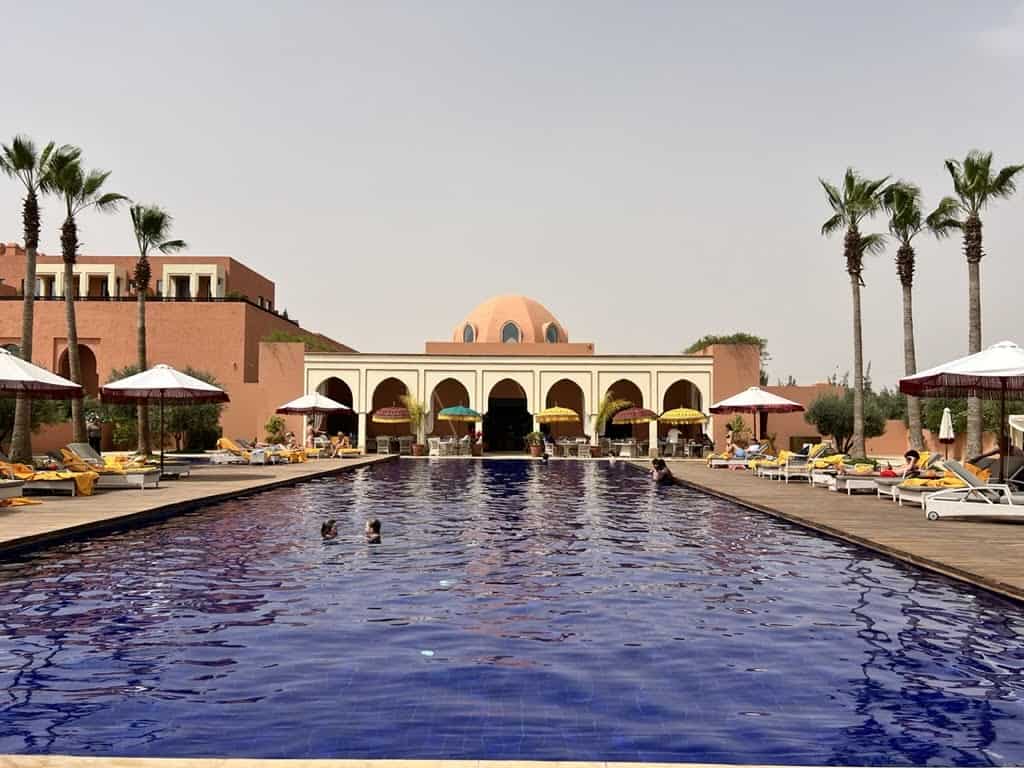
But here’s a seasonal breakdown to help you find your sweet spot.
Spring (March to May) – Our Favorite Time
If Marrakesh were a person, spring is when it’s freshly showered, wearing a nice linen shirt, and in a very good mood. Days hover in the 70s to low 80s (°F), evenings are breezy and orange blossoms scent the air like someone spilled artisanal perfume across the city.
It’s perfect for strolling through the souks without melting, sipping mint tea on riad rooftops and even day-tripping to the Atlas Mountains without needing a portable AC unit strapped to your back. If you work remotely, caf3s and co-working spaces feel alive but not chaotic.
Summer (June to August) – Proceed with Caution
This is when the sun forgets its boundaries and just goes full tyrant. Temps regularly hit 100°F (38°C+), and locals will tell you they don’t even go out in the afternoon. If you’re not used to this kind of heat, or your laptop overheats faster than your patience, this might not be your season.
That said, prices are lower, and some riads have plunge pools or shaded courtyards that feel like secret oases. If you’re good at early mornings and lazy siestas, you might just make it work.
Fall (September to November) – Another Sweet Spot
Imagine spring but with a slightly earthier color palette. The heat starts to fade, but the post-summer vibrancy remains. Markets are lively, the sunsets feel extra cinematic and it’s prime time for remote workers to set up shop in Moroccan cafes and crank through deadlines between tagines.
Winter (December to February) — Crisp, Quiet, and Cozy
Don’t expect snow, but do pack a jacket. Winter in Marrakesh is mild by Canadian standards (we’ve lived through Vancouver’s moody winters and Kelowna’s brisk ones), but the mornings and nights get chilly. Especially in older riads with no central heating.
The upside? It’s calm. Fewer tourists, more room to breathe in the souks, and that soft golden light photographers live for. If your idea of remote work includes quiet cafes and steaming lentil soup, this might be your time.
Bonus: Festivals & Events Worth Planning Around
- Ramadan: A sacred and beautiful time, but it will affect opening hours, especially during the day. Travel during Ramadan can be peaceful and spiritual if you’re respectful and flexible.
- Marrakech Popular Arts Festival (July): Big performances, folk music, cultural shows — but again, brace for the heat.
- Oasis Festival (September): If electronic music, poolside parties, and desert chic are your vibe, this one’s for you.
Where to Stay in Marrakesh
Picking where to stay in Marrakesh is half the fun, half the confusion. I spent a couple weeks trying to figure out where we wanted to stay. You’ve got everything from 300-year-old riads with birds chirping in the courtyard to ultra-modern Airbnbs in the French district, to palace hotels that make you feel like you should’ve arrived on a camel caravan in a past life.
During our stay, we actually tried a little bit of everything and we recommend you also try to incorporate this approach in your Marrakesh itinerary – a classic riad inside the Medina (because, of course), an Airbnb with fast Wi-Fi in Gueliz (because work), and a cheeky night of indulgence in a palatial resort just outside the city (because… why not?).
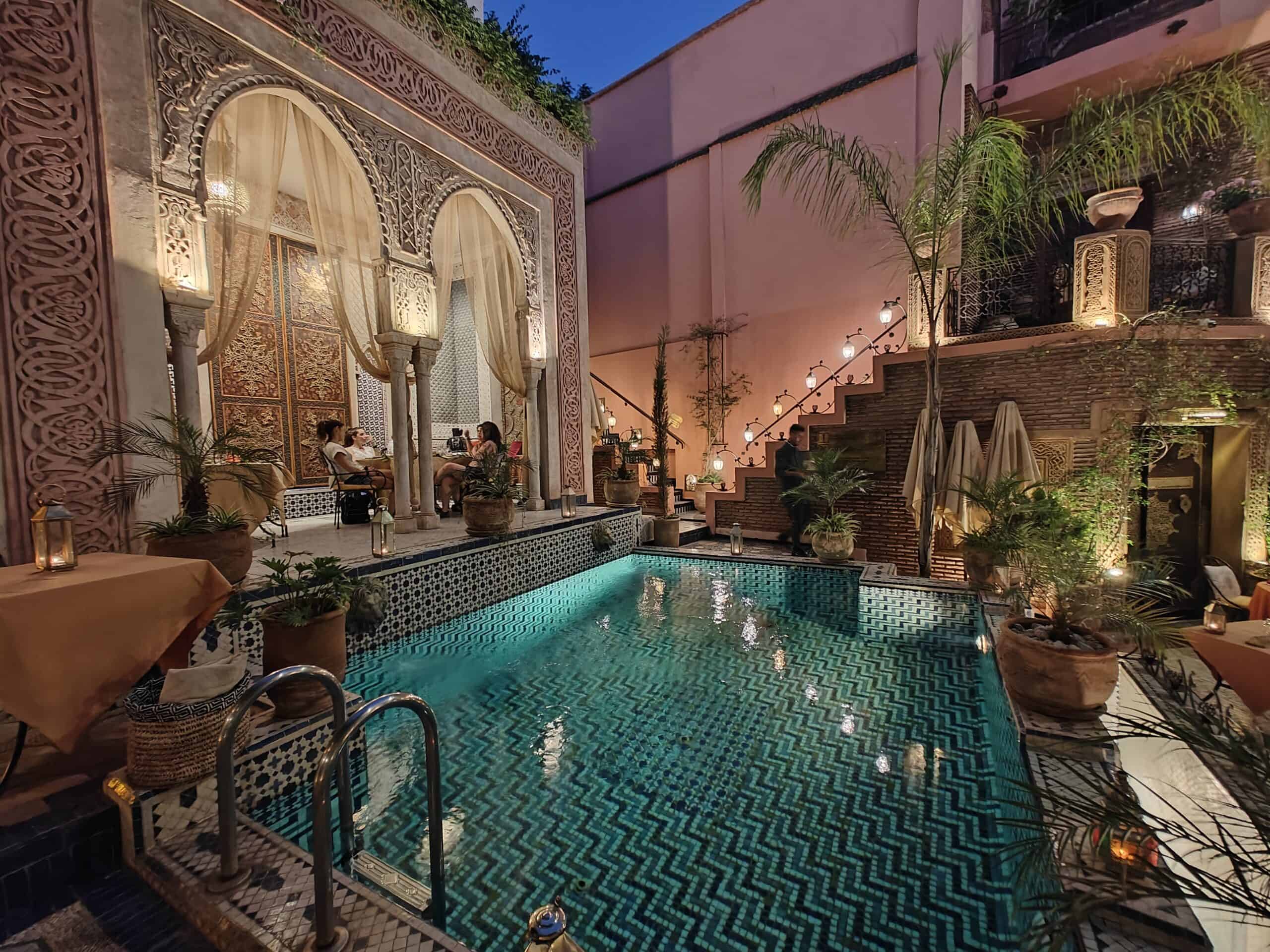
The Riad Experience – Living Inside a Moroccan Dream
If it’s your first time in Marrakesh, staying in a riad is a must. These traditional Moroccan houses, centered around inner courtyards, are tucked inside the Medina’s chaos like serene little pockets of magic. You’ll open a nondescript wooden door from a dusty alleyway and walk into a mosaic-covered, rose-petal-sprinkled world with birds fluttering overhead and mint tea waiting.
We stayed at Riad Palais Sebban, and honestly, it felt like the building was whispering secrets from centuries ago. Our room had intricately carved wooden ceilings, tiled floors that begged to be Instagrammed, and a rooftop perfect for remote work mornings – shaded and breezy with just enough ambient Medina buzz to keep things interesting.
Other incredible options we bookmarked (and snuck into for dinner or a hammam):
- Riad Yasmine – Famous for its photogenic pool, but still warm and welcoming.
- Riad Ksar Kasbah & Spa – Minimalist but luxe. Their hammam is legit.
- Dar Darma – For artsy souls. Like sleeping in a living museum.
Best For: First-timers, couples, aesthetics lovers, or anyone who wants to feel like royalty with a breakfast of msemen and fresh orange juice served in a sun-dappled courtyard.
Watch out for: Patchy Wi-Fi (ask ahead if you need to work!), alleyway confusion (the first few days are a maze), and occasional noise at night since the Medina never truly sleeps.
Gueliz & Hivernage – Modern Airbnbs + Remote Work Friendly
After a week of navigating the Medina like semi-lost cats, we moved to a sleek Airbnb in Gueliz, Marrakesh’s French-influenced district. And suddenly, it felt like we’d time-traveled.
This part of the city has wide boulevards, European-style cafes, actual traffic lights (!!), and a lot of laptop-friendly spots. We’d start our mornings working from Bloom House Coffee, sipping espresso or iced lattes and watching chic locals glide by. The rhythm here is calmer, more “liveable”, especially for those doing longer stays or working remotely.
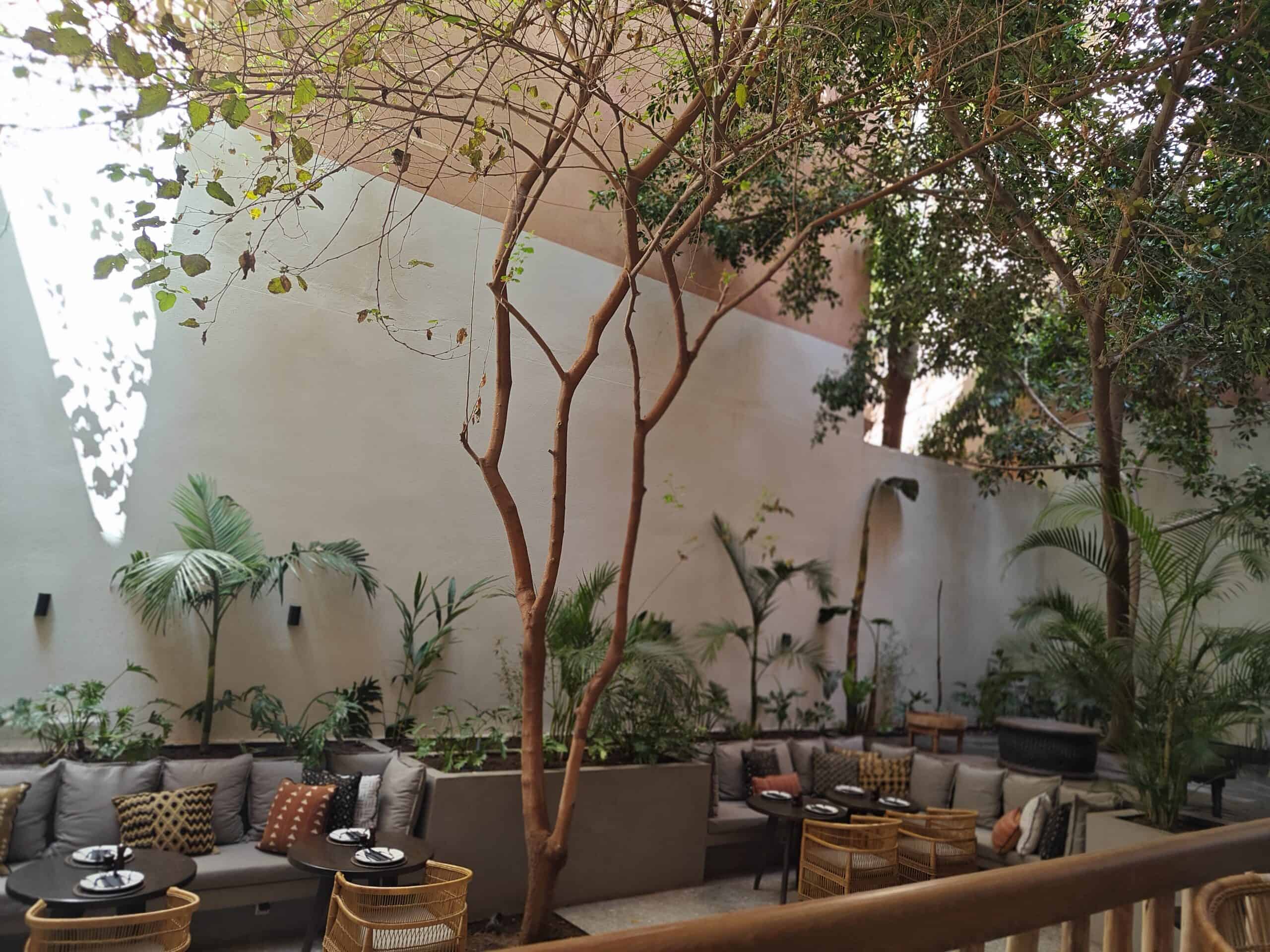
Our Airbnb was a one-bedroom flat with a balcony and rock-solid Wi-Fi – for less than what we’d pay in Canada for a basic hotel room. Plus, it was walking distance from everything: shops, cafes and even a Carrefour when we felt like cooking.
Best For: Digital nomads, longer stays, cafe lovers, people who want to take breaks from the Medina’s intensity.
Watch out for: It doesn’t have the same “wow, I’m in Morocco!” feeling as the Medina. More practical than romantic.
Palatial Escapes – For When You Want a Cinematic Stay
Now let’s talk indulgence, because there is so much of it in a Marrakesh itinerary, all optional ofcourse. One weekend, we splurged on a night at The Oberoi Marrakech. And it was like staying inside a dream sequence. You’re technically still in Marrakesh, but it feels like you’ve been transported to some serene, palm-lined utopia where every detail, from the tilework to the lighting, is meticulously perfect.
Huge gardens, reflective pools, candle-lit hallways, and breakfast that goes on for days. The room came with a private terrace, and we didn’t see another human until check-out (except our butler. Yes, butler).
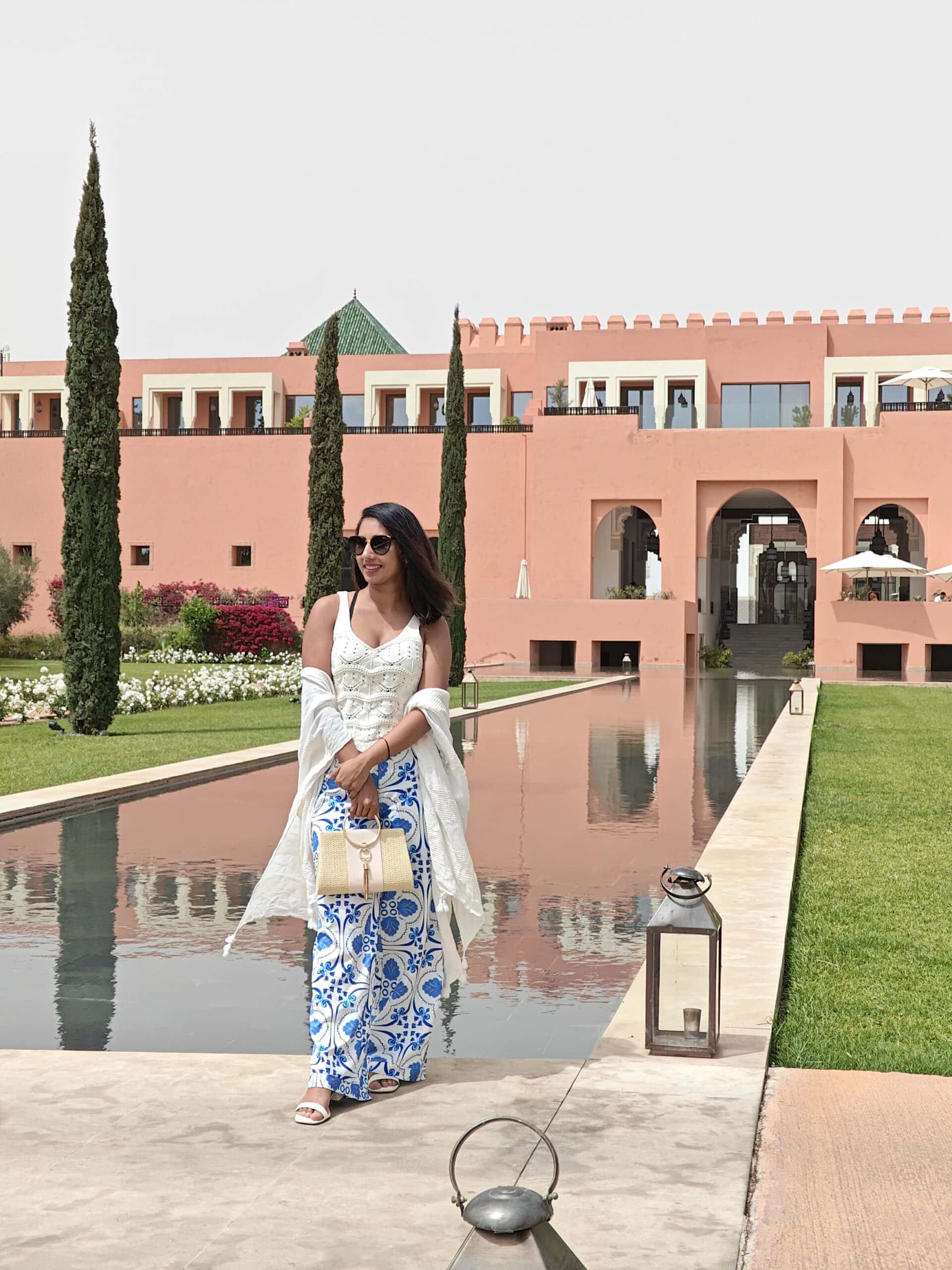
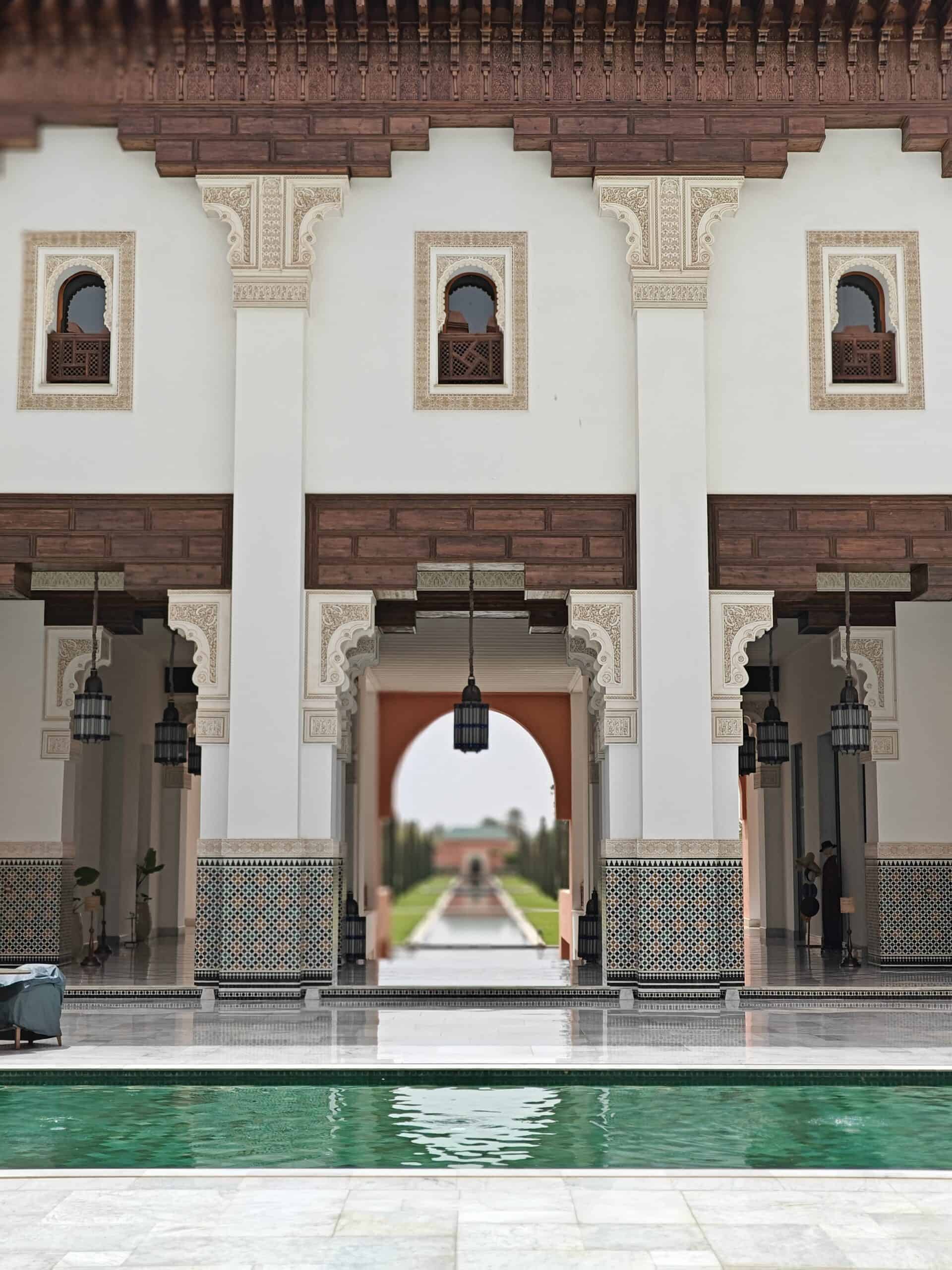
Other palatial picks that caught our eye:
- Royal Mansour – Owned by the King of Morocco. Yes, that level of royal.
- Amanjena – Peaceful, pink, palatial. You’ll want to dress the part.
- Selman Marrakech – For those who want horses, architecture, and glam in equal measure.
Best For: Honeymoons, birthdays, “we deserve this” weekends, or luxury travelers looking to be cocooned in comfort.
Watch out for: Distance from the Medina (you’ll need a driver), and prices that can make your credit card sweat.
Pro Tip - There is a local ride sharing app that you can use - InDrive. The app is unique as it allows you to negotiate pricing. It is frowned upon by taxi drivers, but hey, it still works and is much cheaper!
So.. Where Should You Stay?
If it’s your first visit, start in a riad for a few nights to soak in the magic. Then switch to an Airbnb in Gueliz if you’re working remotely or staying longer. And if the budget allows, treat yourself to a night or two in a palace. Trust us, even one night is enough to feel like you’ve lived a whole different life.
Marrakesh Itinerary Overview
Before we get into the nitty-gritty of what to do each day, let’s take a breath and ask the golden question: How many days do you really need in Marrakesh?
Short answer: 3 to 5 full days is ideal.
Long answer: It depends on how much time you want to spend lost in the souks, lounging on rooftop terraces, or drinking your weight in mint tea.
We stayed for over two weeks, but we split our time between getting work done in the mornings, exploring at a relaxed pace, and building in those deliciously slow afternoons where we’d just chill in a courtyard or wander aimlessly.
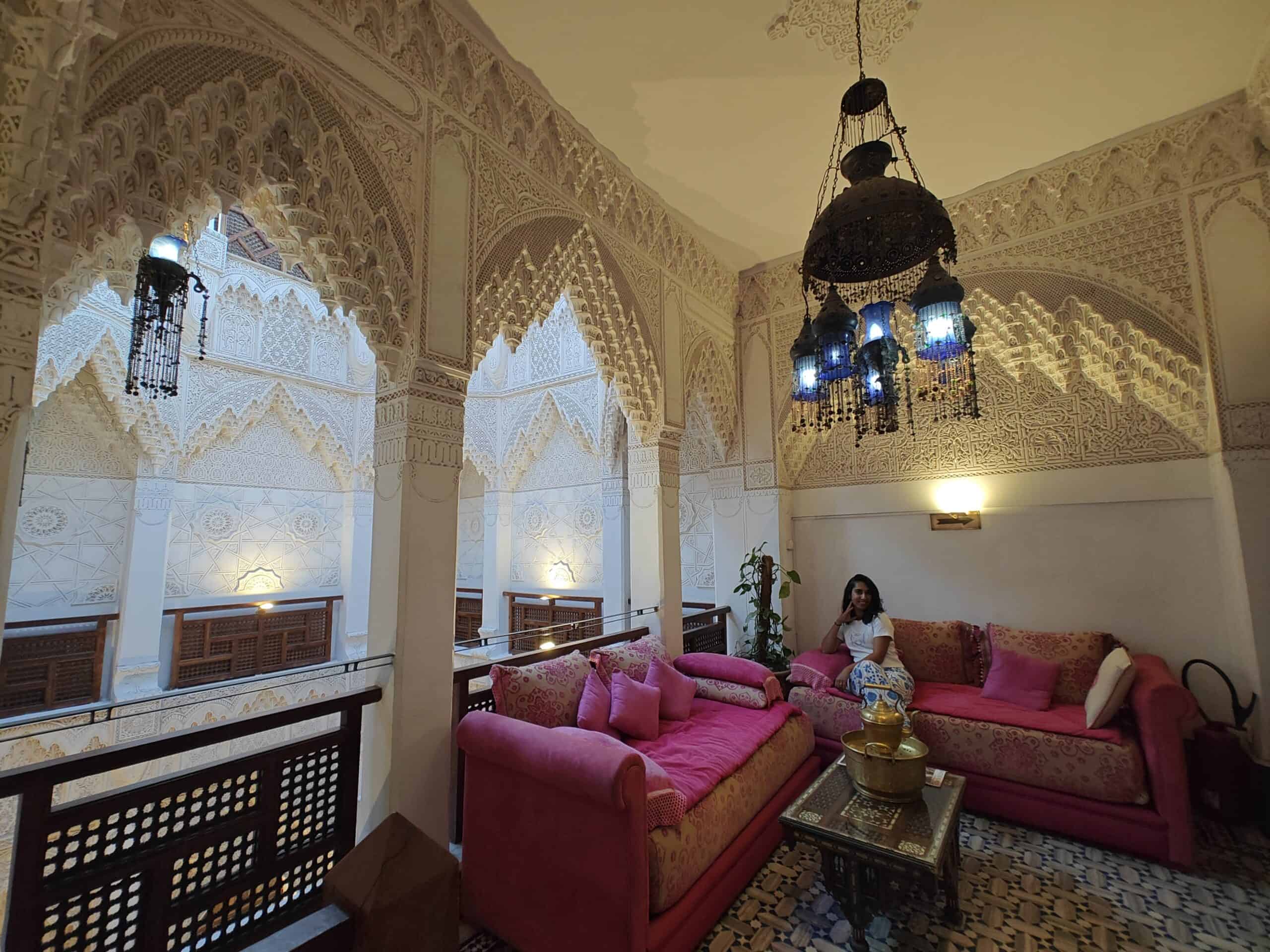
So here’s how to think about planning your days:
If You Have 3 Days in Marrakesh
You’ll want to focus on the essentials – the Medina, the major landmarks, a hammam experience and a few knockout meals. It’s very doable, especially if you don’t try to squeeze in day trips.
We’d recommend:
- 2 days soaking up Marrakesh itself (sights + vibes)
- 1 full day for slower exploration or one well-timed excursion
You’ll leave wanting more, but in a good way. Every time I’m on a flight out of a place, I judge my stay based on how badly I wanted to stay for longer.
If You Have 4 Days
Now you’re talking. This gives you the full Medina experience plus a little room to breathe. Maybe add a food tour or escape to the Agafay Desert for a half-day without feeling rushed.
This was the sweet spot for a few friends who visited us while we were there. It allowed them to check out both the “must-see” and the “I’m-so-glad-we-stumbled-on-this” stuff.
If You Have 5 Days or More
You’re living the dream. With 5+ days, you can:
- Mix up energetic market days with restful ones
- Explore museums and hammams at your own pace
- Work a bit if you’re remote like us, then reward yourself with tagine
- Take a full-day trip to the Atlas Mountains or a scenic dinner in the desert
- Discover corners of the city that don’t show up on every blog post
Our Travel Philosophy (and How It Shapes This Itinerary)
We’re not into squeezing 17 things into a day just to say we’ve done them. This itinerary isn’t built for that. It’s for people who:
- Like to walk slowly and look up
- Say “let’s go left instead” for no reason
- Work a few hours in the morning from a cozy cafe
- Make lunch last two hours and dessert last longer
- Enjoy the magic of sitting still in beautiful places
So if that’s your vibe, you’re in good company. Our day-by-day breakdown coming up is designed to hit the highlights and leave you time to be spontaneous. Because honestly, the best moments in Marrakesh aren’t always the planned ones – they’re the unexpected conversations, the quiet corners and the times you forget what time it is.
Day 1: Souks, Squares, and Saffron Sunsets
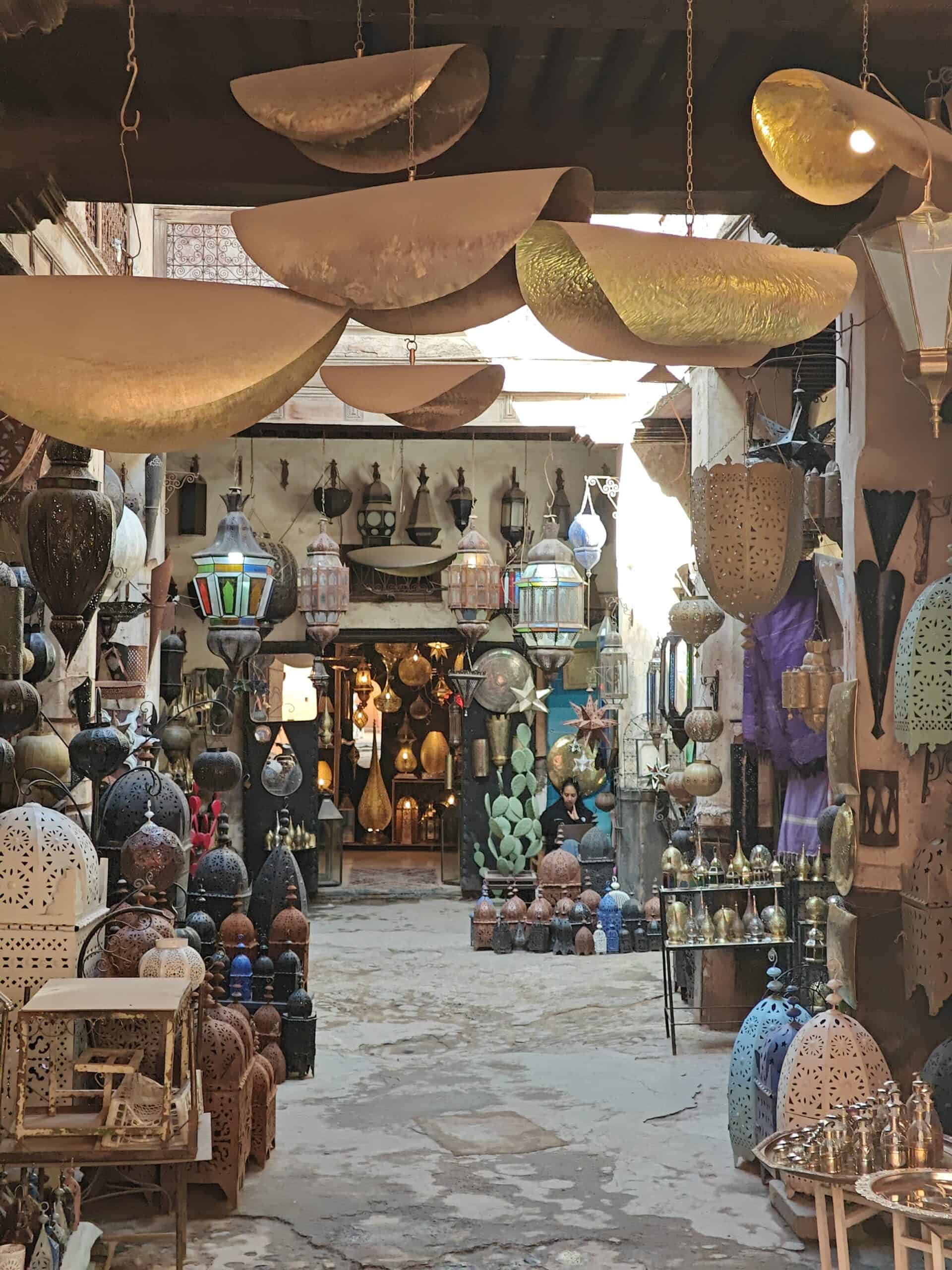
So you’ve landed in Marrakesh, hopefully not too jet-lagged and you’re ready to dive into the heart of the city. Don’t overplan today! Let the place come to you a little. Marrakesh is a sensory overload, especially on your first day. It smells like spice, sounds like snake-charmers and scooters, and looks like a fever dream of mosaic and sunlight. You’ll want your head up, your heart open, and your camera.. somewhere not in your hands all the time.
Here’s how we’d do Day 1, a mix of structured discovery and aimless meandering.
Morning: Lazy Rooftop Breakfast & First Wander
Start your day slow. Trust me. There is no award for rushing into the souks before your coffee kicks in.
If you’re staying in a riad (especially one like Palais Sebban or Riad Ksar Kasbah), breakfast will probably be served on the rooftop or in a courtyard, complete with fresh-squeezed orange juice, olives, flatbreads, jams and mint tea poured with a level of flair you will never achieve at home.
Let yourself linger. This isn’t a trip you’re trying to survive. It’s one you want to savor. Then, set out for your first real steps into the Medina.
Midday: Airbnb Walking Tour (Yes, It’s Worth It)
Marrakesh’s labyrinthine Medina is a beast. Streets curve for no reason, Google Maps is drunk half the time, and every stall selling spices looks like the one before it until you realize you’ve circled back to the same point three times.
Enter: the Airbnb Experience walking tour. There are a bunch, but look for ones hosted by born-and-raised Marrakshis who know the backstories behind the souks, the gates, the hammams and the old trading routes. It will help you gain a better appreciation for your Marrakesh itinerary.
The one we did took us through:
- Bab Agnaou gate
- The Blacksmiths’ Souk, where the clang of metal is oddly rhythmic
- Rahba Kedima, the old spice square where you’ll learn more about cumin than you ever asked
- Madrasa Ben Youssef, where you’ll struggle to get pictures without people in them but just looking at the architecture is enough.
- And a few secret terraces that you’d never find alone
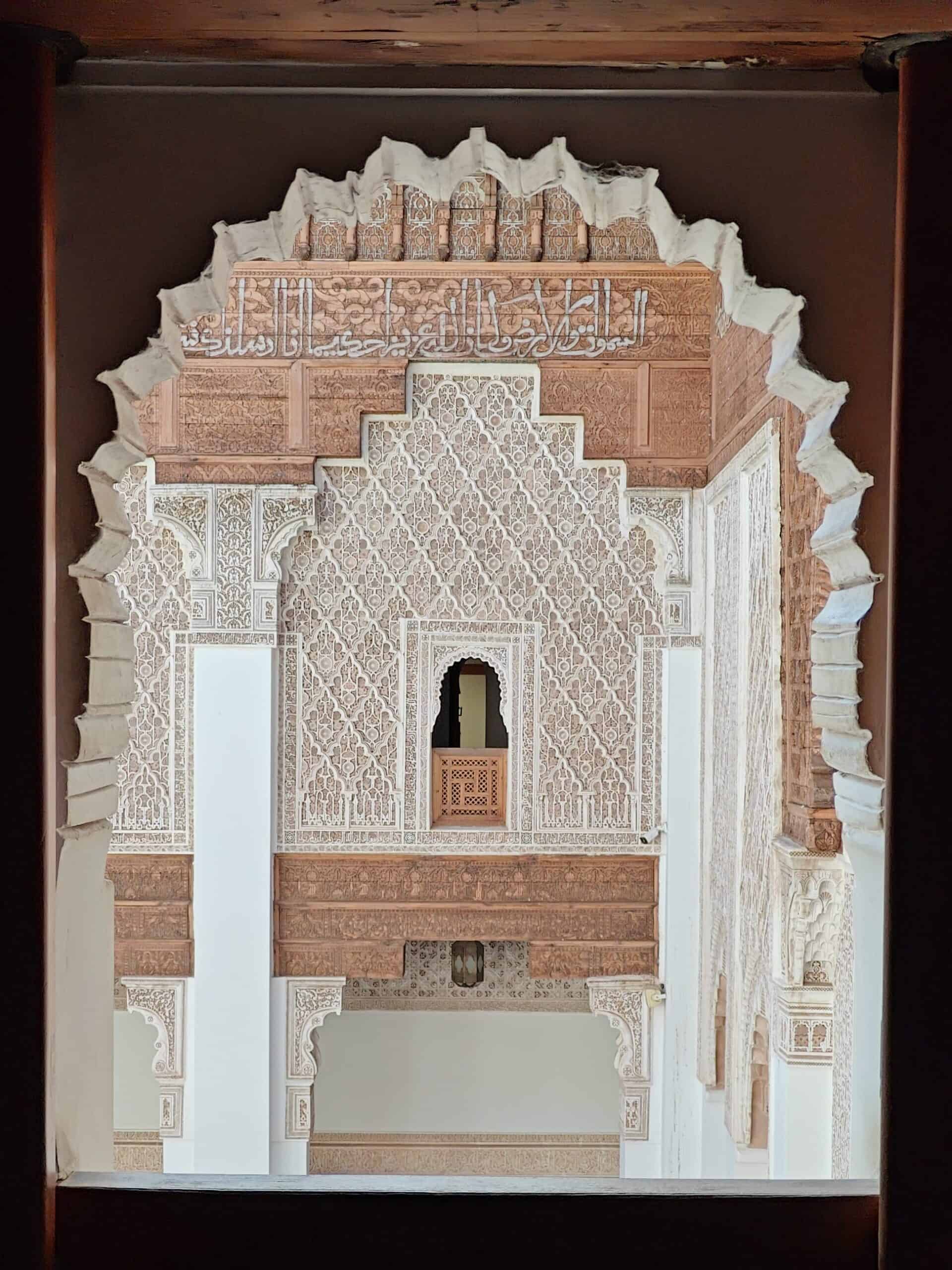
It was 2-3 hours long, full of stories and humor, and helped us actually understand what we were seeing later when exploring solo. Plus, it made us feel way less like lost tourists.
Cost? Around $20–30 per person. Value? Immense.
Afternoon: First Tagine & A Bit of Calm
After all that walking, bargaining, and dodging donkeys (yes, really), you’ll want lunch and a soft chair. Head to Nomad, a rooftop restaurant perched over the souks with incredible views and equally great food.
Our go-to order:
- A veggie tagine with preserved lemon and olives
- Zaalouk (smoky eggplant spread)
- And always the fresh juice of the day
Pro tip: The rooftops have shade, but they’re sun traps midday. Grab a hat, sunglasses, and some SPF.
After lunch, if you’re working remotely, this is a good window for a couple of hours of laptop time, either back at your riad or in a cozy cafe in Gueliz (if you’re staying there).
Late Afternoon: Koutoubia Mosque & Chill Time
Even if you don’t go inside (non-Muslims can’t enter), Koutoubia Mosque is a city icon. Its minaret rises like a compass point, helping lost souls (i.e., us) re-orient in the Medina. The gardens around it are peaceful, with benches under orange trees and the occasional cat doing its cat thing.
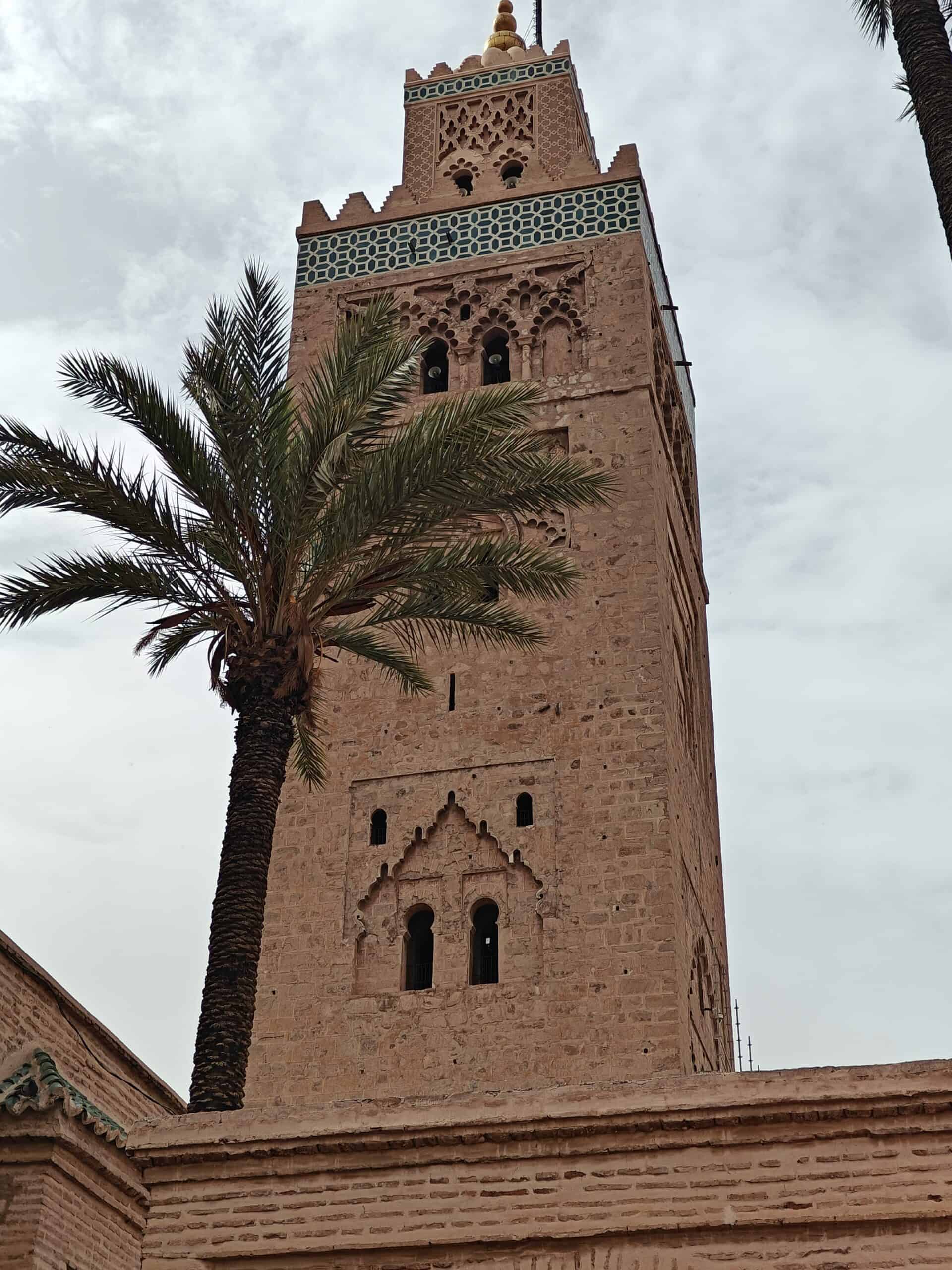
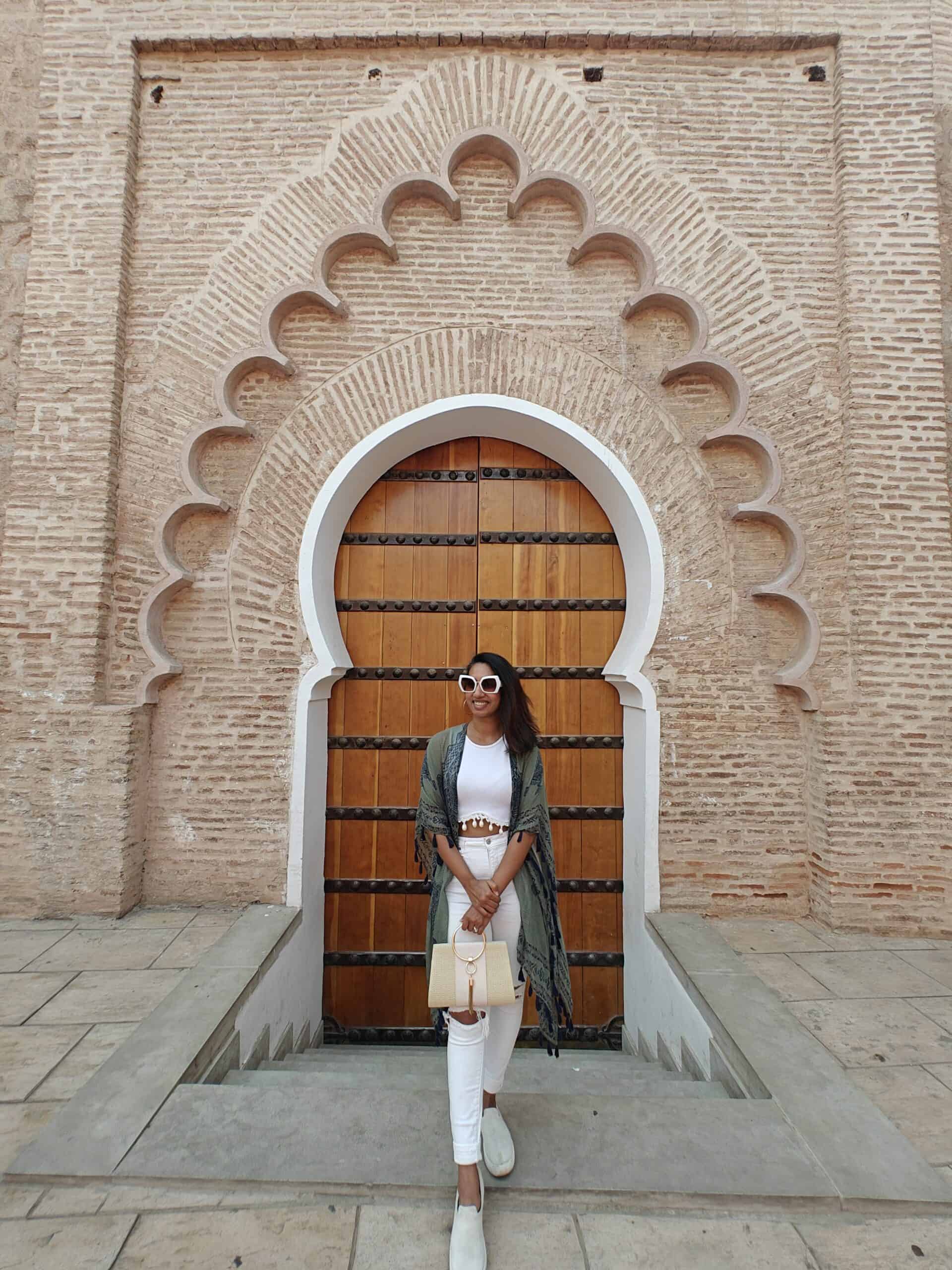
This is a nice reset point. A moment to slow down again before the sunset madness begins.
Sunset: Jemaa el-Fnaa from Above
Yes, it’s touristy. Yes, it’s chaotic. But Jemaa el-Fnaa, the main square, is still one of those places you have to see with your own eyes, especially as the sun starts to dip.
But. Don’t just walk around the square. Experience it from above.
Grab a spot at Le Grand Balcon du Cafe Glacier or Cafe de France, order a mint tea or a soda, and just watch. Drummers start warming up, snake charmers and storytellers gather crowds, smoke rises from food stalls, and everything turns gold-orange-magenta as the call to prayer echoes.
It’s pure sensory cinema.
Dinner: Casual & Close
After sunset, if you’re not overwhelmed (or desperately in need of a shower), you can venture back down into the square for dinner. There are hundreds of food stalls, most chaotic, some magical. If you’re nervous about hygiene or decision fatigue, go to Mechoui Alley instead. Slow-roasted lamb, served old-school style. (We don’t eat much meat, but even I was tempted by the smell alone.)
Pro tip: Do not drink the orange juice from street vendors unless you are used to such places. We have many American and Canadian friends who've fallen sick after having these.
Otherwise, head to a nearby riad restaurant for a quieter dinner – Le Jardin or Dar Cherifa offer charm, calm, and great Moroccan fare.
Optional Nightcap: Rooftop Views or Hammam Wind-down
If you’re feeling fancy and want to toast to your first day, grab a drink at El Fenn’s rooftop bar. It is trendy, stylish and very expat-friendly.
If your feet hate you and you’re nodding off into your couscous, this might be a good night to book a quick hammam. Yes, really! Several spots offer shorter, more casual night sessions.
Day 2: Palaces, Hammams and Hidden Gardens
By now, the initial sensory overload has mellowed into fascination. You’ve figured out how to cross a street without dying, you’re only mildly lost in the Medina and your tastebuds have fallen hard for preserved lemon and cumin.
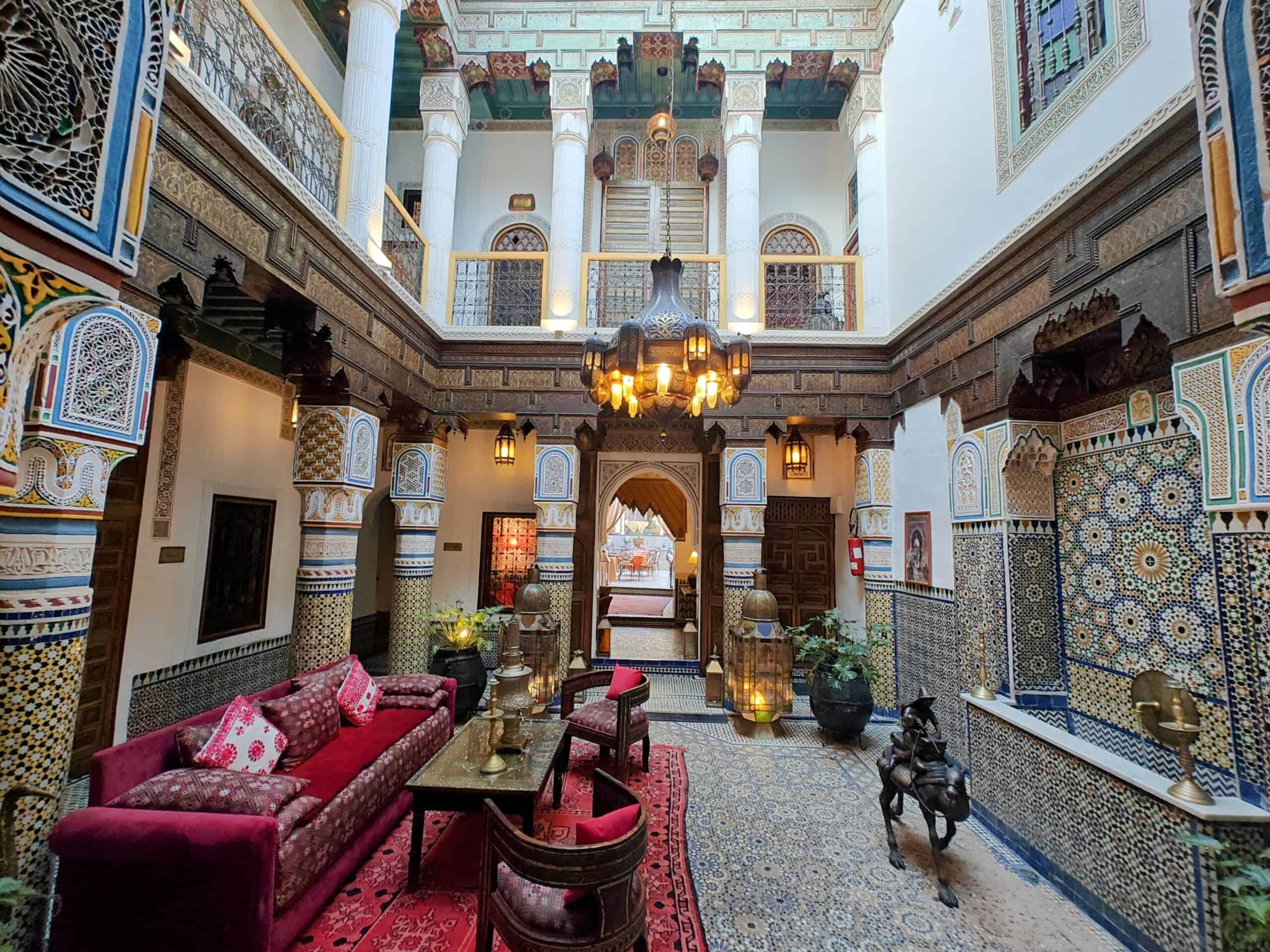
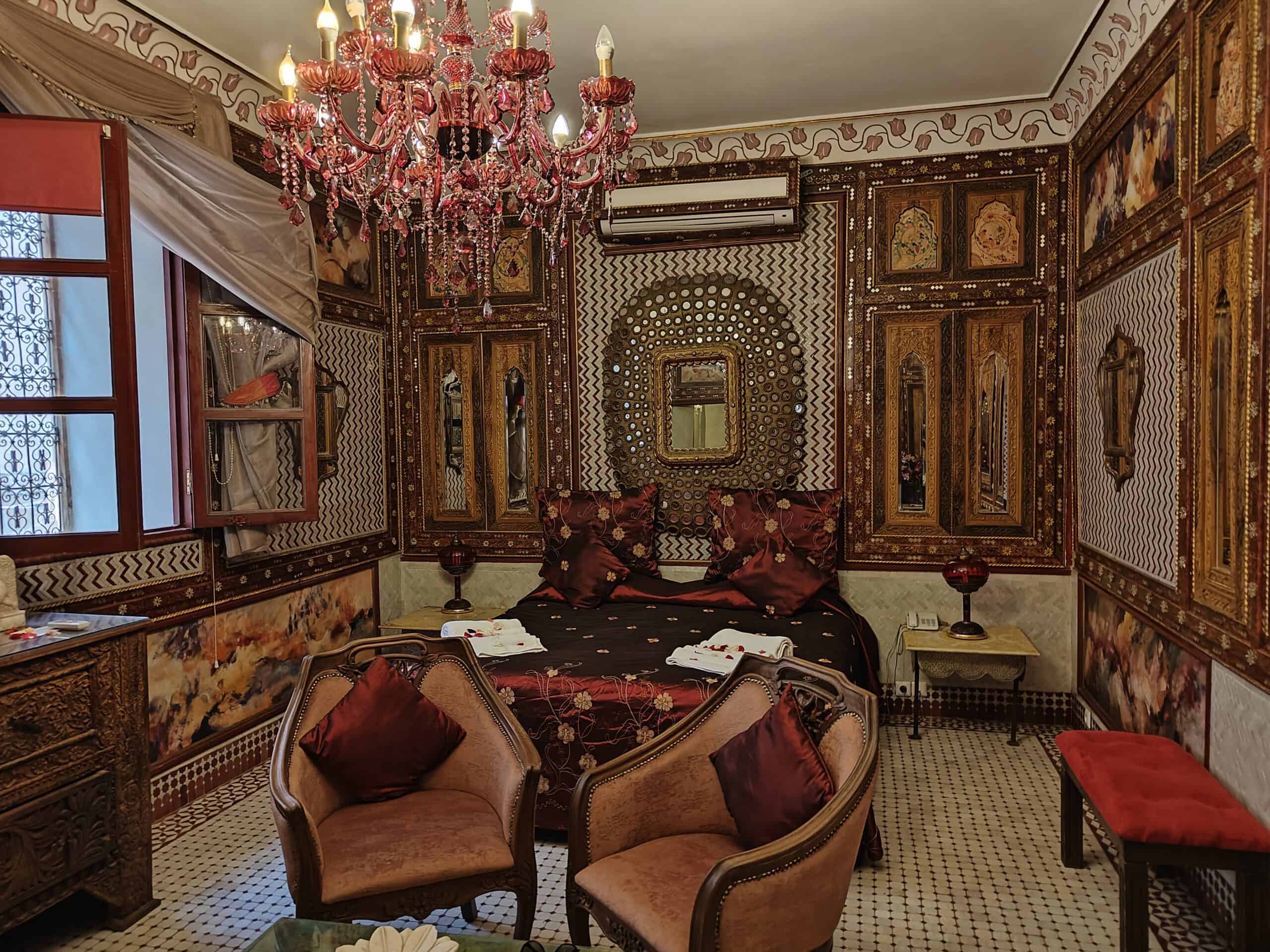
Day 2 is about pulling back the curtain a bit. Literally and metaphorically. Behind Marrakesh’s dusty walls lie lush oases, architectural stunners and a whole spa culture that basically forces you to slow down. You’ll love it.
Morning: Palaces and Painted Ceilings
Start your day early. Not too early (we still need to live a little), but before the tourist wave hits. Grab a quick breakfast at your riad or a cafe near Dar el Bacha if you’re staying in Gueliz. Then make your way toward two of the city’s most iconic palaces:
1. Bahia Palace
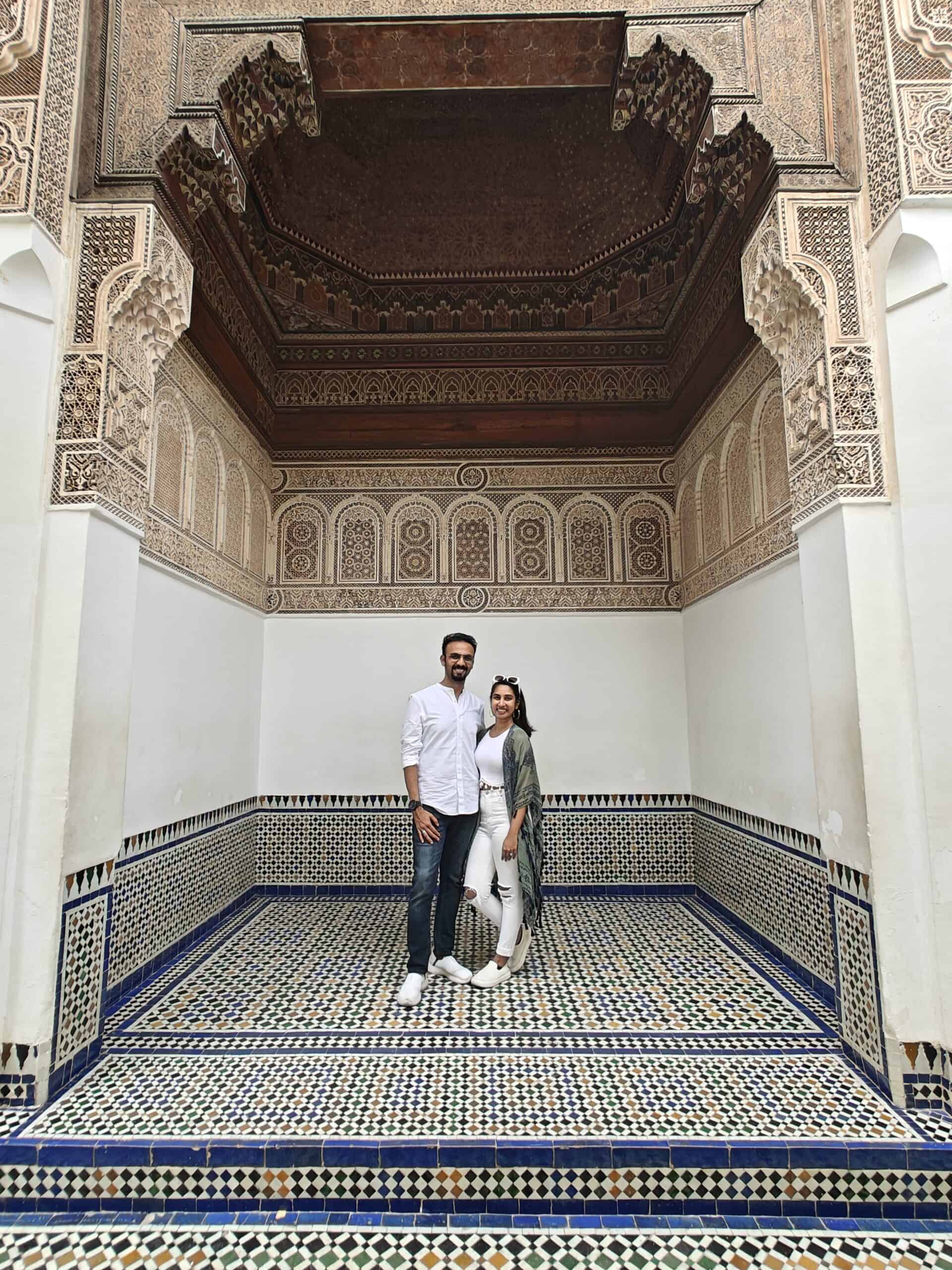
A 19th-century masterpiece that’s all about tilework, zellij, and those “wait, this was someone’s house?” moments. It’s huge, so don’t rush. Wander through the courtyards, look up at the hand-painted cedar ceilings and soak in the peacefulness of a place that used to be home to viziers, wives and concubines.
Entry: 70 MAD ($7 USD)
Go early (by 9:30 AM) to beat the tour groups
2. El Badi Palace
More ruin than residence, but still absolutely worth it. This 16th-century palace is a stunning contrast to Bahia. Less polish, more power. Picture sun-bleached stone, crumbling towers, nesting storks (!), and sweeping views from the ramparts. It’s got that post-apocalyptic beauty, especially in golden morning light.
Entry: ~70 MAD
Don’t skip the underground prison chambers. They’re eerie and cool
Midday: Slow Lunch & a Coffee Fix
After playing royalty all morning, you’ve earned a good meal and probably a proper espresso. Head toward Le Jardin. This is a leafy, shaded oasis with green tile, vintage vibes, and a menu that mixes Moroccan and international. If you’re vegetarian like me or just done with meat for a bit, they’ve got delicious couscous, lentil salads and grilled veggie platters.
If you’re working remote and want to squeeze in an hour or two (like we did), Bacha Coffee is close by and honestly one of the most beautiful cafs we’ve ever worked from. Gold accents, 200+ coffee blends, and leather-bound menus. It’s extra, in the best way. And the Wi-Fi? Surprisingly solid.
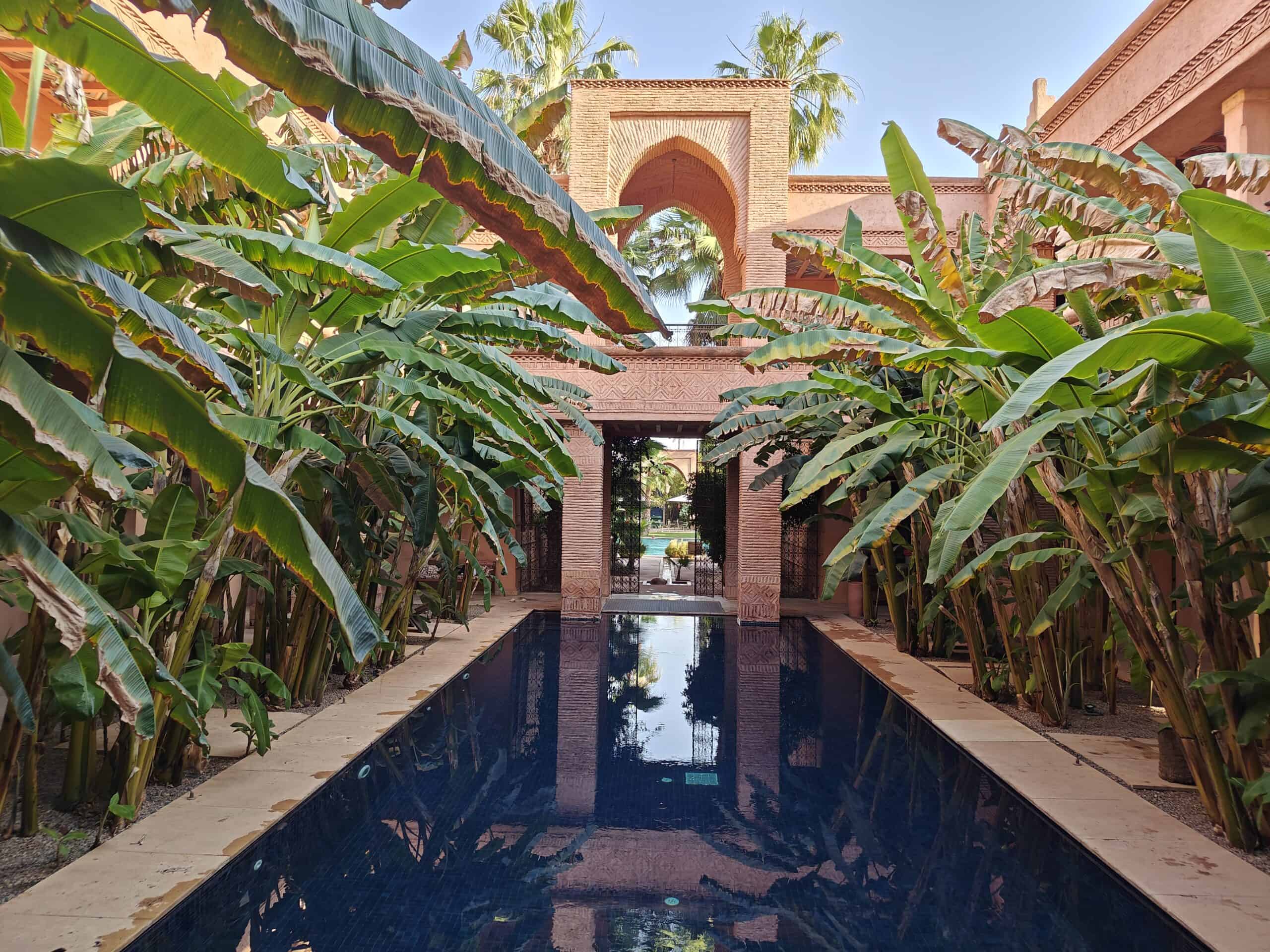
Afternoon: Secret Gardens & Serene Wandering
You’ll want something chill after lunch, trust me. This is when the heat creeps in and the crowds thicken. But hidden inside the walls of the city are two beautiful green spaces that feel nothing like the world outside.
1. Le Jardin Secret
A quiet, restored riad garden right in the heart of the Medina. Think pathways through citrus trees, fountains trickling in tiled courtyards, and enough benches for a mid-afternoon reading break. It’s small, but soul-soothing.
Entry: ~80 MAD
Bring a book or just sit and watch the shadows move. We stayed way longer than we meant to.
2. Maison de la Photographie (Optional, but worth it)
A tiny museum showcasing vintage photos of Morocco. Street scenes, Berber families, early 20th-century life. Bonus: their rooftop has one of the best quiet views over the Medina. If you want a little culture without the overwhelm, this is it.
Entry: ~50 MAD
Also a good spot for golden hour if you time it right
Evening: Hammam Time (Just Do It)
Let’s talk hammams! Moroccan bathhouses that range from “local steam-and-scrub” to full-on spa luxury, and should be on your to-do list in a Marrakesh itinerary. If you’ve never done one before, here’s the short version:
You get scrubbed in a steam bath. You leave reborn.
For your second night in Marrakesh, we’d recommend easing in with a mid-range or luxury hammam that caters to travelers. You’ll still get the cultural experience, but with less risk of awkward nudity or skin trauma.
Our picks:
- Les Bains de Marrakech – Stylish, professional, and relaxing. Their spa packages include hammam, massage and tea lounging.
- Hammam de la Rose – More boutique, slightly cheaper and super chill.
Expect to pay ~300-600 MAD depending on treatments.
Tip: Book ahead. Evening slots go fast.
You’ll emerge squeaky clean, a little dazed and deeply relaxed.
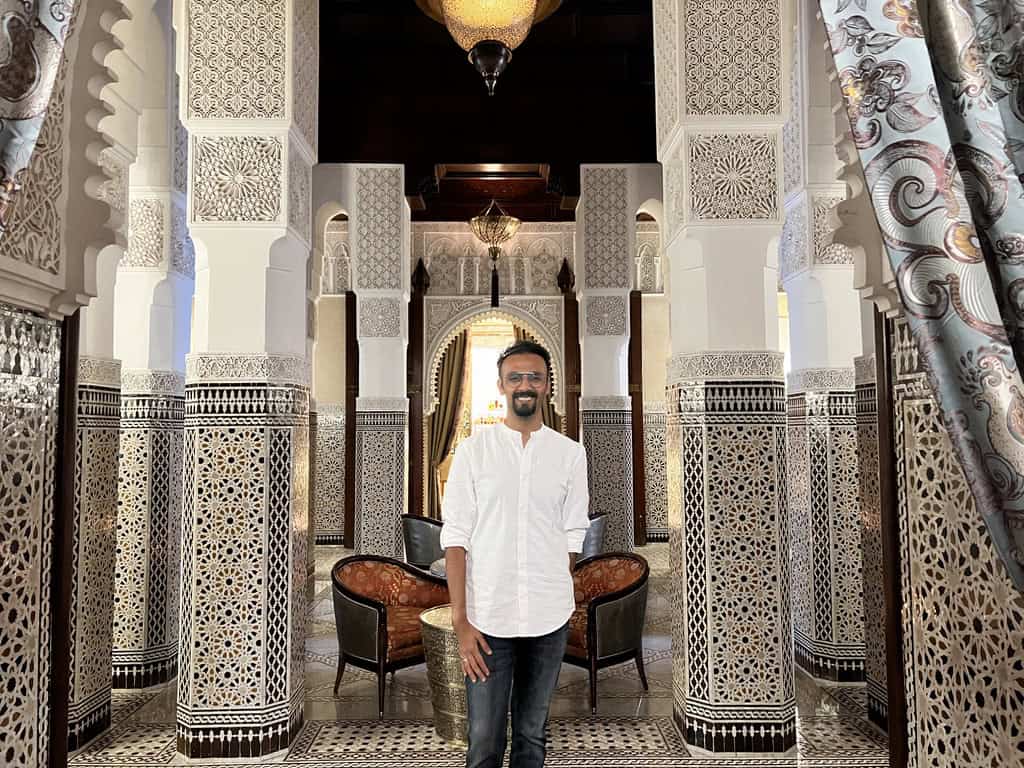
Dinner: Rooftop Dining With a View
After your hammam, you’ll want something soothing. Both for your tastebuds and your newly exfoliated soul. Head to Atay Cafe or Kui Zin, two laid-back rooftop restaurants with excellent tagines, good vibes and sweeping Medina views. Neither are stuffy, both are affordable, and you’ll eat under strings of lights as the city hums below.
Optional upgrade: Dinner at El Fenn. We found it to be beautiful, buzzy, and a little pricier, but worth it for a special night.
Optional Nightcap: Night Souk Wandering
If you’ve still got energy, take a short post-dinner wander through the Medina. It feels different at night. Less frantic amd more magical. Lamps glowing, spices scenting the air, cats slinking between stalls.
You don’t need to buy anything. Just walk. Let the city wrap around you. Stay safe and don’t go into dark alleys.
Day 3: Desert Vibes, Rooftop Dining & Night Market
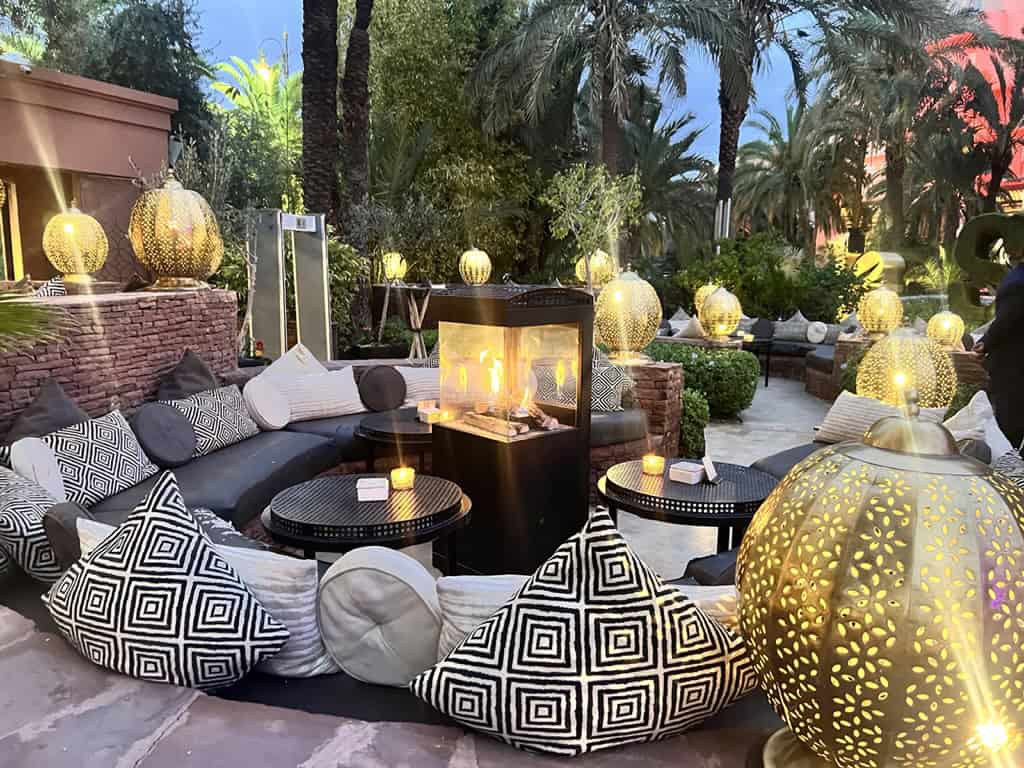
By now, you’ve probably found your rhythm: mornings slow, afternoons golden, and evenings electric. You’ve stopped checking maps every 5 minutes and you’ve started recognizing alley cats.
Morning: Coffee, Camels & the Agafay Desert (Optional Half-Day Escape)
If you’re craving a breather from the Medina’s intensity, consider booking a half-day trip to the Agafay Desert. It’s only about 40 minutes outside the city, and while it’s not the Saharan dunes, the vibe is still magical. Think golden hills, rocky plains, Berber tents and camel rides with a side of mint tea.
We booked ours via GetYourGuide. There are loads that offer:
- Morning pick-up from your riad
- Quick stop for coffee and dates
- Short camel ride or quad bike option
- Time to lounge in a tent and soak in the silence
You’ll be back by early afternoon, just in time for lunch.
Pro tip: Bring a scarf or light jacket as it can get windy, and you’ll want the classic windswept desert shot.
Staying In? Work From Somewhere Cozy
If you’re skipping the desert (or saving it for Day 5), this is a great morning to slow down and get some work done. We walk you through how to get a remote job and enjoy like we do right here. We alternated between two of our favorite remote-friendly cafés:
- MyKawa – Great Wi-Fi, minimalist design, oat lattes, and good sandwiches
- Plus61 – A little fancier, but if you’re a brunch + inbox kind of person, this place is heaven
Bonus: both have outdoor seating and no pressure to rush. We’d often do 2-3 hours of work, knock out a couple meetings and then really enjoy the rest of the day.
Afternoon: Long Lunch & Hidden Boutiques
Once you’re back (or done working), treat yourself to one of the city’s best slow lunches. Our absolute favorite?
La Famille. A garden restaurant tucked behind a plain wooden door near the Medina. The food is Mediterranean-Moroccan fusion, vegetarian and absurdly good. The kind of place where every plate looks like it belongs in a cookbook.
Try:
- The lemon risotto with preserved lemon and herbs
- Their house lemonade (not too sweet, not too sour)
- And their ever-changing dessert. We had a citrus olive oil cake we still dream about.
(Reservations help. It’s that good.)
After lunch, if you’re up for it, poke around the nearby boutiques and concept stores:
- 33 Rue Majorelle – Moroccan design meets modern chic
- Max & Jan – Great for fashion and homeware
- Soufiane Zarib – If you’re considering checking a carpet (or three?)
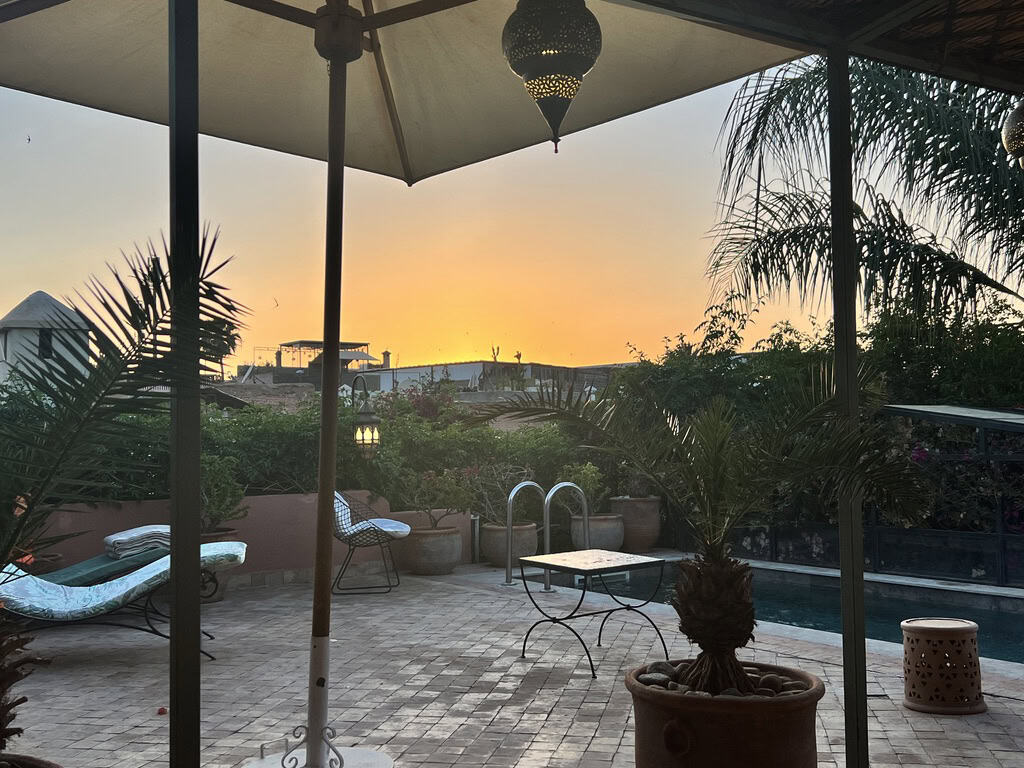
Late Afternoon: Sunset on a Rooftop
There’s just something about watching the sun dip over the Medina with a drink in hand and a call to prayer echoing in the background. We made a whole ritual out of it.
Two incredible sunset spots:
- Kabana Rooftop – Think palm trees, tropical cocktails, upbeat music, and a young-ish crowd. Good for that “am I in Marrakesh or Tulum?” vibe.
- El Fenn Rooftop – Elegant, artsy and romantic. Come for a glass of Moroccan rosé or a non-alcoholic spritz and stay for the golden hour lighting.
Good news! They’re both great for couples, groups or solo travelers.
Evening: Night Market or a Local Food Tour
Now that your feet are warmed up and your confidence is high, it’s time to tackle Jemaa el-Fnaa by night. The food stall edition. This is another must-do in any Marrakesh itinerary.
Here’s how to survive (and enjoy) it:
- Walk around first. Don’t sit at the first table someone shouts you toward.
- Look for stalls crowded with locals (always a good sign)
- Go small: grilled kebabs, harira soup, fried eggplant or sardine sandwiches
Not into playing food roulette? No judgment. Book a street food tour via Airbnb Experiences or GetYourGuide. The guides will:
- Walk you through the stalls
- Tell you what’s safe, tasty and actually local
- Share history, spice tips and secret sauces
- Usually end with dessert and tea somewhere amazing
We did one with a host named Hassan who grew up in the Medina and could identify every spice by smell. It was the kind of night that makes you feel connected to a place.
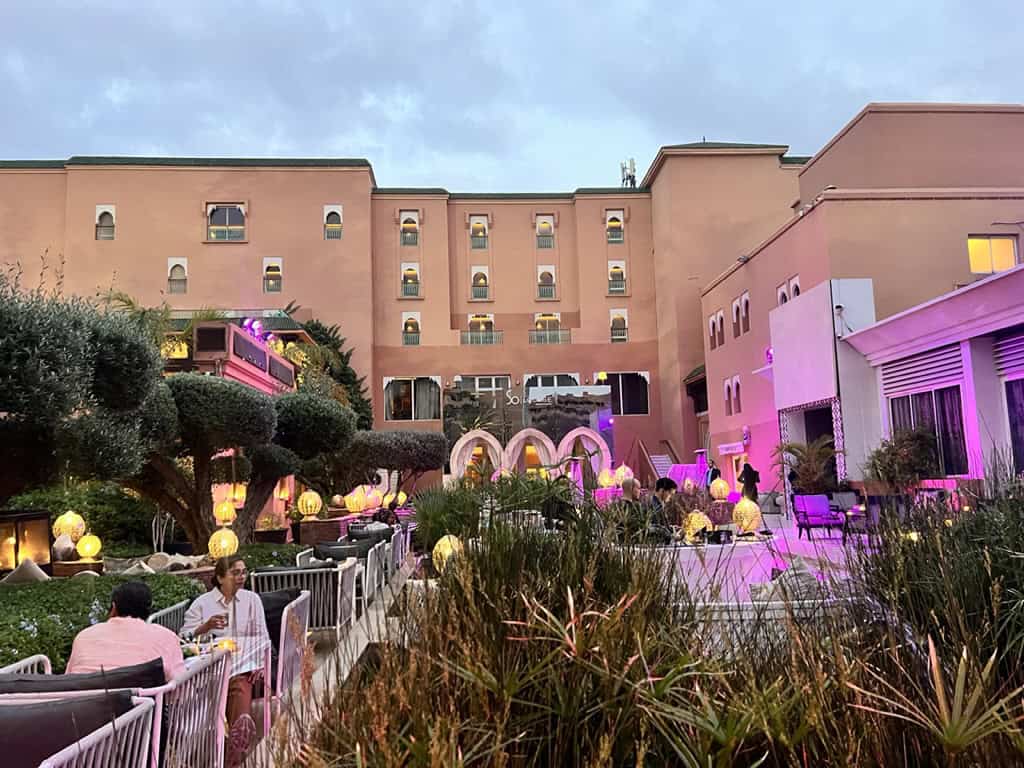
Optional Wind-down: Hookah Lounge or Quiet Courtyard
If you’re not ready to call it a night, head to a local hookah (shisha) lounge – they’re everywhere in Gueliz and Hivernage. Most are mellow, some are sleek, and many serve fresh juices, herbal teas or Moroccan cocktails (yes, that’s a thing). If looking for something classy, head to So Lounge in Sofitel.
If that’s not your scene, just head back to your riad. The silence of those inner courtyards after dark is something else. Maybe grab your Kindle, a glass of wine (if you brought some) and let the tiled walls work their magic.
Day 4: Atlas Escape or Urban Slow Travel
By Day 4, most travelers fall into one of two camps:
- “Let’s get out of town for a day.”
- “I need one day where I don’t do much of anything.”
Luckily, Marrakesh is perfect for both. We did a bit of both over our two-week stay. One day for hiking and mountain tea and another for long cafe hours, people-watching, and letting the city unfold with zero plans.
So here’s your fork in the road:
Option 1: Day Trip to the Atlas Mountains
If you’re craving cooler air and mountain views, this is the move. There are dozens of Atlas day trips you can book in this Marrakesh itinerary (we used GetYourGuide) and most follow a similar rhythm:
- Morning pick-up from your riad or Airbnb
- Drive out past olive groves and clay villages toward the Ourika Valley or Imlil
- Short guided hike with a local Berber guide (nothing too strenuous)
- Stop at a Berber family home for mint tea and fresh bread
- Lunch at a riverside cafe where tagines bubble over coal fires and your toes basically touch the water
The air is crisp, the pace is slow, and the contrast with Marrakesh is awesome.
Pro tips:
- Wear sturdy shoes, even for short hikes as trails can be rocky
- Bring layers. It gets chilly, especially in winter
- Be generous with your guide since many of them support entire families with this work
You’ll be back in Marrakesh by early evening, tired in the best possible way.
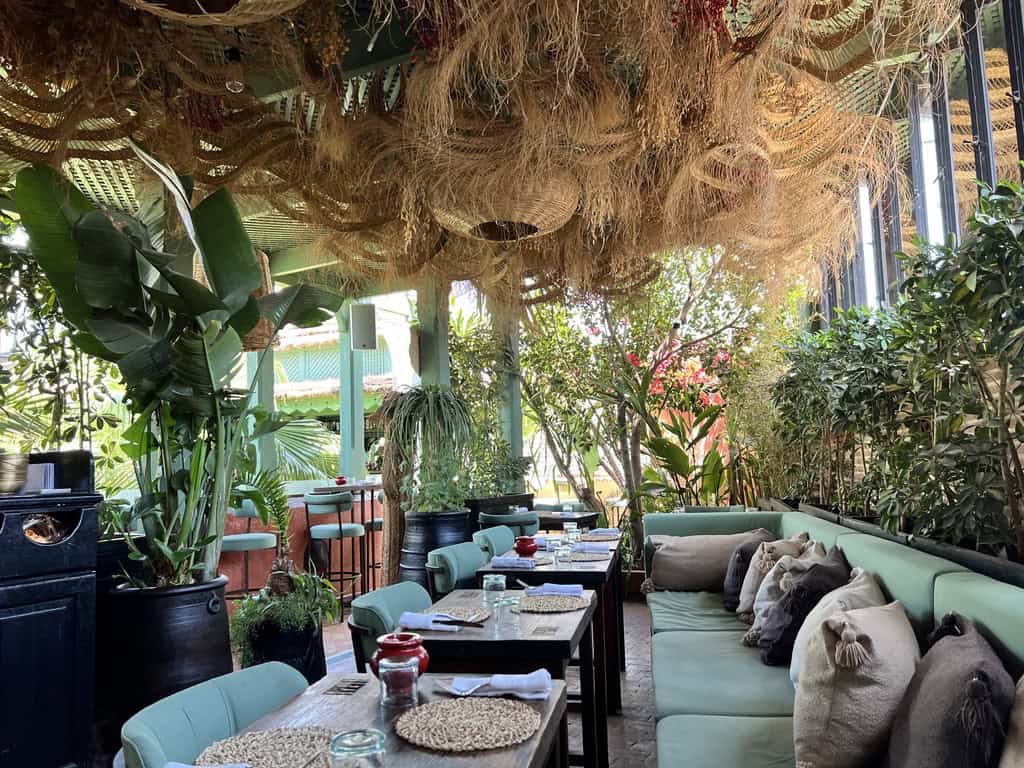
Option 2: Urban Slow Travel Day
Didn’t sleep well? Want to enjoy your riad’s breakfast at an aggressively slow pace? Feel like journaling for two hours? You’re our kind of traveler.
This version of Day 4 is all about giving yourself permission to not do everything. You’ve already seen the big sights. Now it’s time for small joys.
Here’s how we structured ours:
Long Coffee & Quiet Time
We started the day at Kafe Merstan, tucked near the northern edge of the Medina. It’s got quiet rooftop corners, proper espresso and slow service in the best way.
We brought our laptops but barely opened them. Sometimes “remote work” just means writing postcards and catching up on photos.
Light Wandering & Artisan Stops
Rather than dive into the main souks again, we focused on the less chaotic artisan alleys:
- Tiskiwin Museum – Small but packed with Saharan and Berber artifacts. Felt more like walking through someone’s curated travel collection than a traditional museum.
- Ensemble Artisanal – Government-run market with fixed prices (no haggling!) where you can browse quality rugs, pottery and leather without being chased down the street.
If you’ve been debating buying something (like, say, a carpet the size of your living room), today’s the day to do it. You’re relaxed, you’ve learned what’s authentic, and you’ve likely found “your guy.”
Afternoon Food Adventure
Lunch = Amal Women’s Training Center
It’s a social enterprise restaurant that supports disadvantaged women, and the food is exceptional. Why not have such a stop on your Marrakesh itinerary? Slow-cooked lamb with prunes, vegan couscous, eggplant zaalouk, fresh juices and homemade sweets. It’s a bit outside the Medina, so grab a cab or walk from Gueliz.
You eat well and do good. Win-win.
Optional Spa Afternoon
Still feeling that hammam buzz from Day 2? Why not double dip?
Book a relaxing massage, facial or Argan oil body treatment at:
- Heritage Spa – Low-key luxe and very welcoming
- Les Bains d’Orient – Great for couples, beautifully designed
If you’ve done enough sweating, even just sitting in their lounge with herbal tea feels like a vacation within a vacation.
Sunset & Dinner (Again.. Rooftop, Always Rooftop)
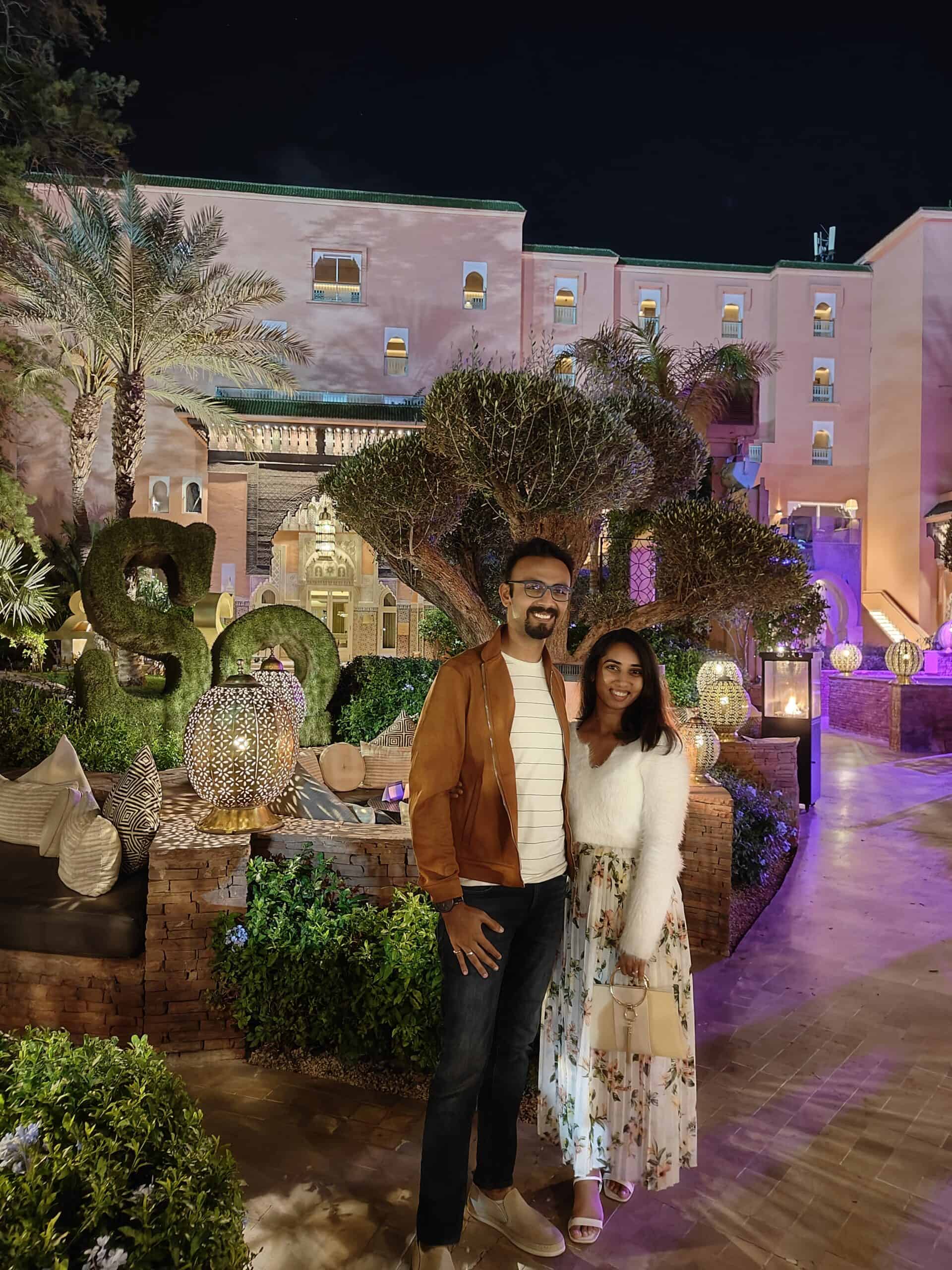
You know the drill by now: golden hour hits differently here.
Try a new rooftop for dinner:
- Dar Dar – Chic, good music, amazing chicken pastilla
- Latitude 31 – Garden dining, fancier vibe, modern Moroccan with a twist
End this night with a long, slow walk back through the Medina , watching vendors wind down, kids play in alleys, cats claim rooftops, and the city take a deep breath before doing it all again tomorrow.
Day 5: Cooking, Culture & Your Own Perfect Farewell
Whether you’re flying out tonight or soaking in one last day, Day 5 is your chance to create, reflect, and close the loop on your Marrakesh chapter.
Morning: Cooking Class (With Couscous You’ll Never Top)
Take a Moroccan cooking class. It’s hands-on, fun and lets you bring home something better than fridge magnets (although get those too!)
We booked ours via Airbnb Experience with a host who taught us how to make:
- Traditional couscous with seven vegetables
- Fresh Moroccan salad with oranges and cinnamon
- And mint tea the proper way (spoiler: you’re probably doing it wrong)
Classes often take place in family kitchens or open-air riads. You’ll grind spices, roast peppers over flame and leave stuffed and proud.
Expect to pay ~$30–50
Some hosts email you a full recipe book after. Gold.
Midday: Last Museum or Chill at a Favorite Spot
If you’re still curious for more culture:
- Dar Si Said Museum (Carpets + decor)
- MACMA (Modern Moroccan art, cool and compact)
- Le Jardin Majorelle + Yves Saint Laurent Museum (Yes, touristy, but the cobalt blue garden is beautiful if you haven’t been yet)
Otherwise? Go back to your spot. That cafe, riad corner, or rooftop you loved the most. Revisit it. Linger. This is your goodbye.
Afternoon: Pack Slowly, Eat Slowly, Leave Softly
Don’t rush it. Buy those last almonds. Say goodbye to the riad staff who now feel like family. Write a postcard. Take one last deep breath of spices and dust and warm air.
And if you’re flying out late, consider a pre-airport dinner at Nomad or Cafe Clock, easygoing, traveler-friendly and open late.
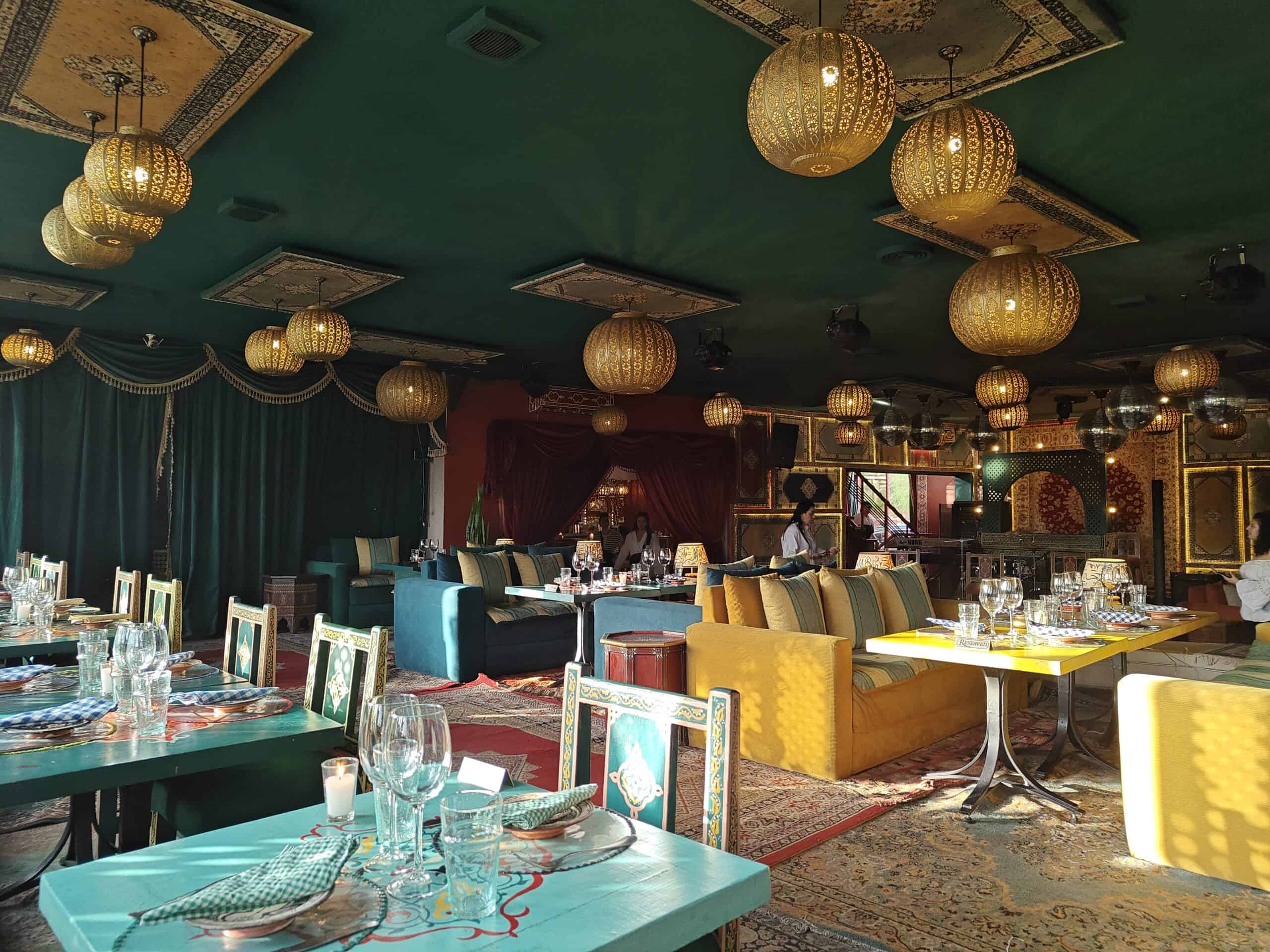
What to Eat in Marrakesh
You could eat tagine every day in Marrakesh and never get bored, but the city’s culinary scene goes far beyond stewed meat and couscous.
Must-Try Dishes
- Vegetable tagine with preserved lemon and olives
- Harira soup – rich, comforting, and often eaten to break fast
- B’stilla – flaky pastry stuffed with spiced veggies or chicken, dusted with powdered sugar (yes, sweet + savory!)
- Zaalouk – smoky eggplant dip
- Sellou – sweet nutty energy snack made during Ramadan
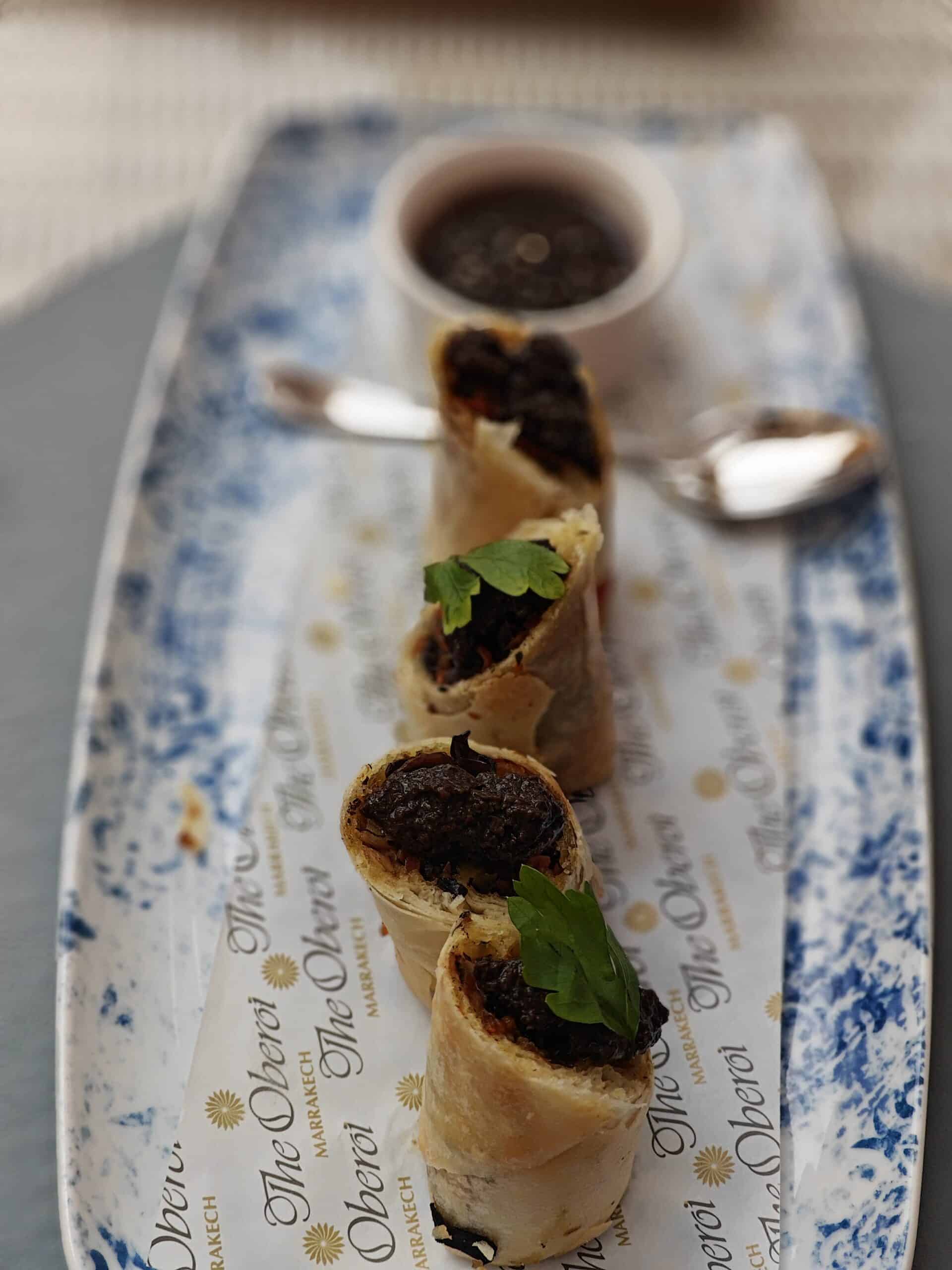
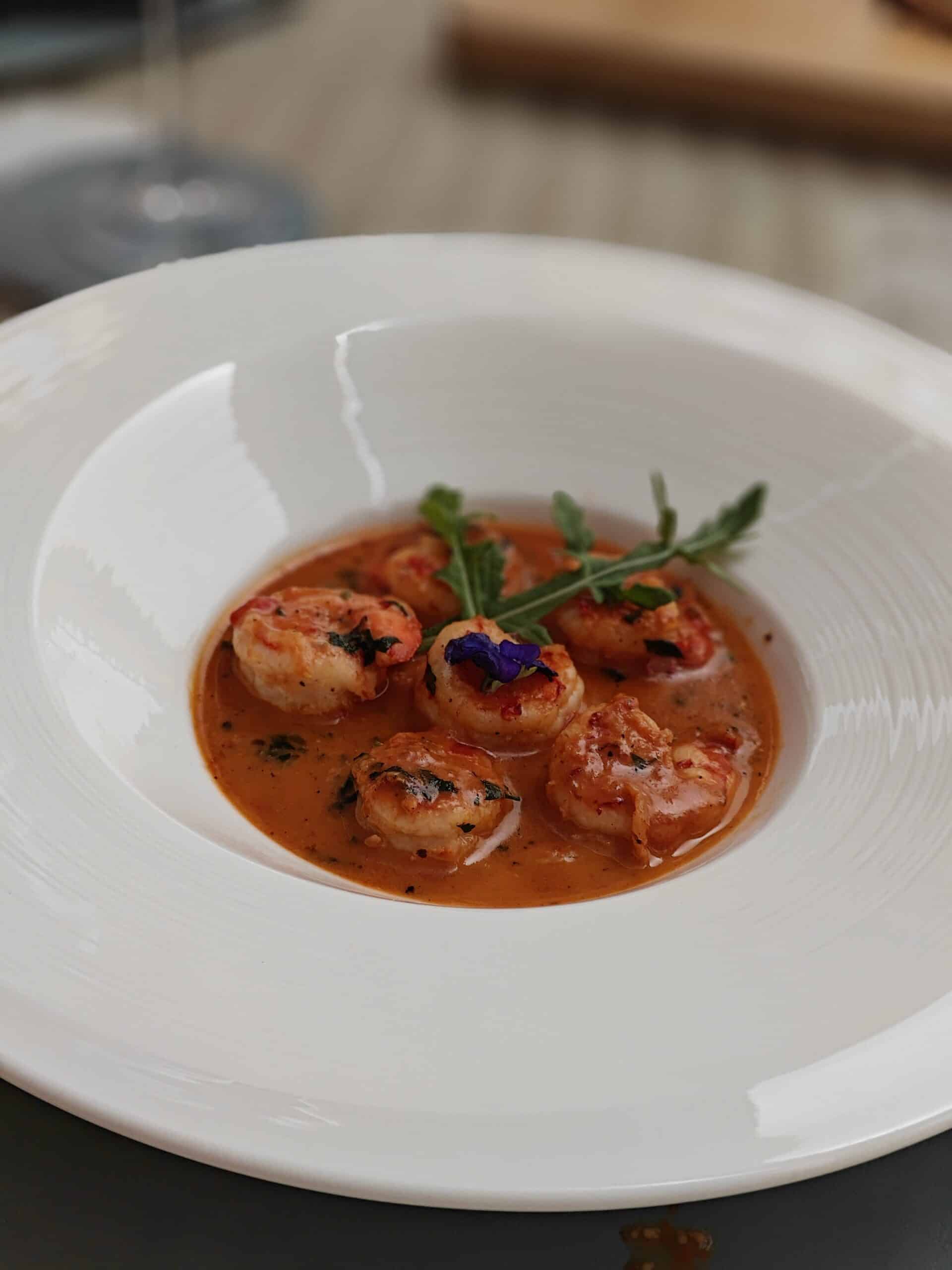
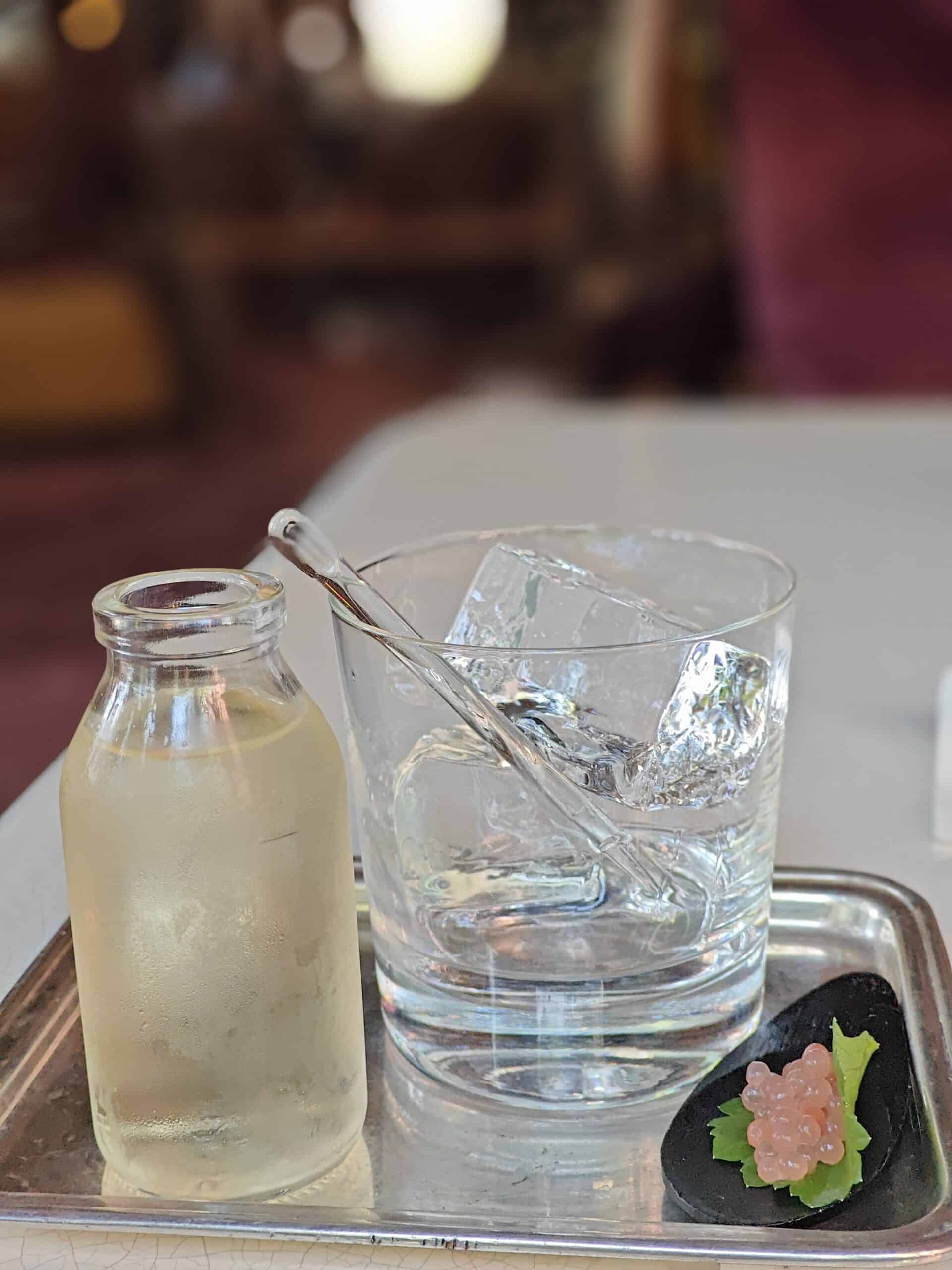
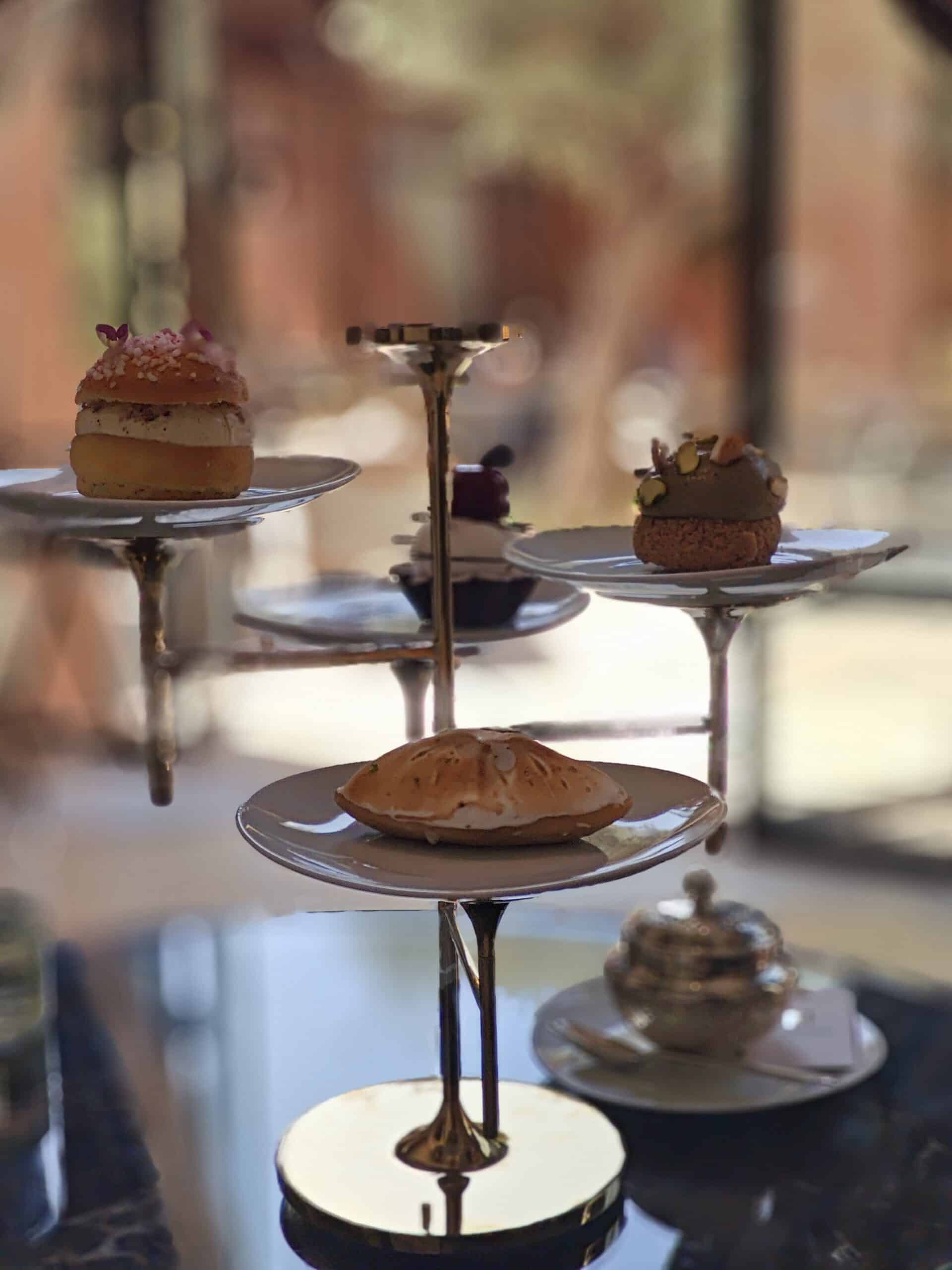
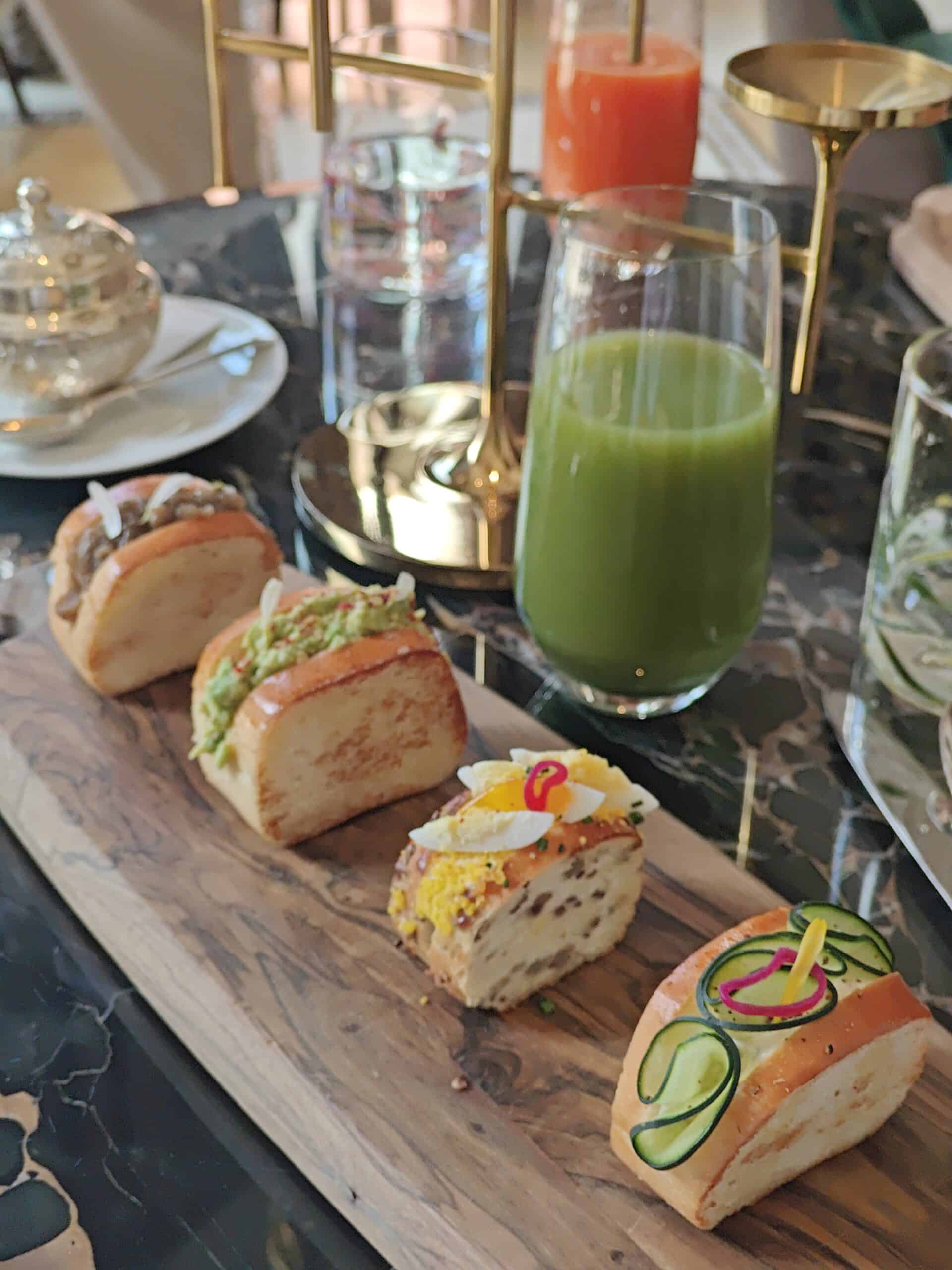
Where We Loved Eating:
- Nomad – modern Moroccan, stunning rooftop
- La Famille – dreamy garden vibes, 100% vegetarian
- Cafe Clock – good for remote workers, camel burger for the brave
- Amal Women’s Center – homey, heartwarming meals with a mission
What to Skip in Marrakesh
We hate being negative, but we’ve also learned that not everything is worth your time. And these are the things we advise you skip from this Marrakesh itinerary.
Overrated or Exhausting
- Snake charmers in Jemaa el-Fnaa – touristy, exploitative, and uncomfortable
- Horse carriages – many animals are visibly mistreated
- Trying to find the “best deal” on carpets – unless you’re in deep, you’ll likely overpay or overthink
Common Scams
- “The mosque is closed today.” (It’s not.)
- “That street is closed.” (It isn’t.)
- Being led to a tannery or spice shop “just to look” – you’ll end up in an awkward high-pressure pitch
Skip the Stress
- Have small change ready (tips, toilets, taxis)
- Know your GPS will fail in the Medina. Accept it.
- Say “la, shukran” (no, thank you) confidently and keep walking
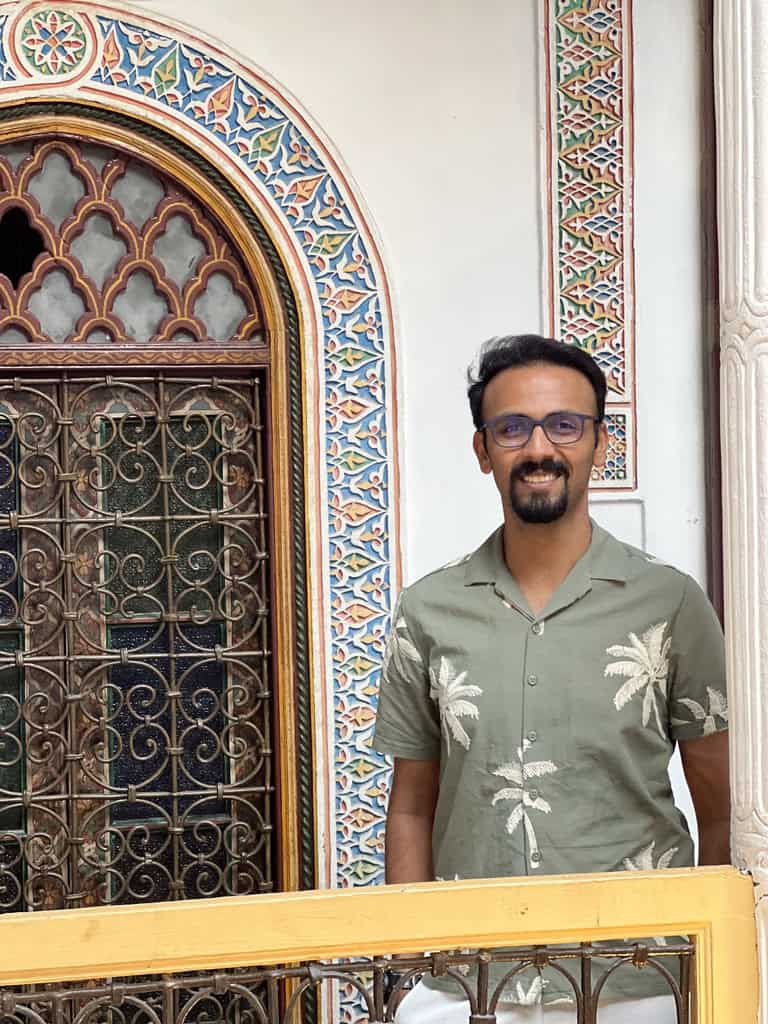
Cultural Tips & Etiquette
Marrakesh is warm and welcoming, but it’s still a conservative city with a rhythm that’s different from Western norms.
Dress:
- Shoulders and knees covered, especially for women
- Flowy layers = comfy and respectful
Behavior:
- Ask before photographing people, especially women
- No PDA in public
- Bargain with humor, not aggression
Language & Tipping:
- Locals speak Arabic, French, and often basic English
- Tip 5-10% in restaurants, 10-20 MAD for hotel staff
Getting Around Marrakesh
Best:
- Walking – especially in the Medina
- Petit taxis – cheap, fast, metered if you insist nicely
- Careem/InDrive app – like Uber, but Moroccan
Worst:
- Renting a car – don’t
- Biking – streets are chaos
Packing List for Your Marrakesh Itinerary
Essentials
- Comfortable closed-toe shoes (yes, even sandals will be tested)
- Light scarf (for sun, dust, or modesty)
- Sunscreen + hat
- Power adapter (Type C / E plugs)
- Reusable water bottle (tap water not recommended)
Optional (but awesome)
- Swimsuit (for riads or hammams)
- Journal or sketchpad (inspiration everywhere)
- An empty tote for all the things you will buy
Final Tips for an Unforgettable Trip
- SIM card: Get one at the airport or from Orange or Maroc Telecom in town. It is super cheap, fast data, easy top-up.
- Cash is king: Many spots don’t take cards. Hit ATMs early in the day, and always carry small bills.
- Respect downtime: Between 1-4 PM, especially in summer, things slow down. Just roll with it.
- Rest often: Marrakesh isn’t about “seeing it all”. It’s about feeling the city. Let yourself sit. Watch. Sip tea.
- Be kind, but firm: Say “non merci” and move on. Most vendors aren’t pushy if you don’t engage.
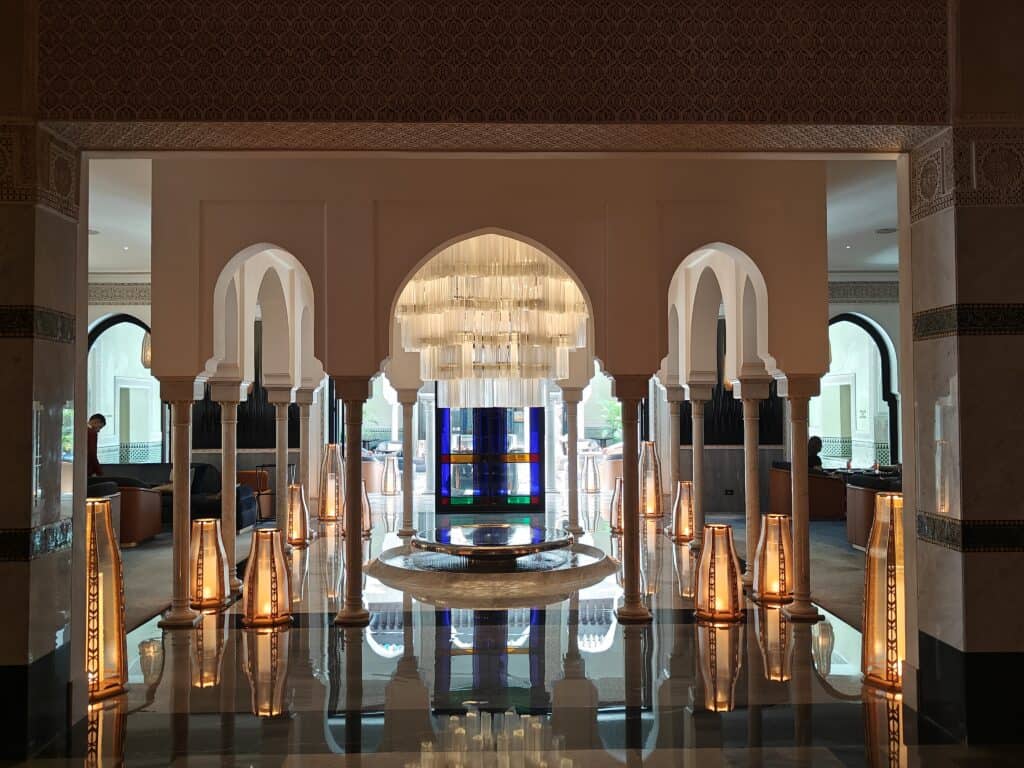
FAQs About Visiting Marrakesh
Is Marrakesh safe for travelers in 2025?
Yes, mostly. Petty theft can happen especially in crowded areas like the Medina, so keep your bag zipped and don’t flash your phone. Locals are overwhelmingly kind and helpful if you get lost. Just stay aware, especially at night, and avoid empty alleys.
How many days do you really need in Marrakesh?
We recommend 3 to 5 full days. It gives you enough time to explore the Medina, relax in a riad, take a hammam, enjoy rooftop dinners and maybe squeeze in a day trip to the Atlas Mountains or Agafay Desert. Any less and it’ll feel rushed.
What should I avoid doing in Marrakesh?
Skip snake charmers, horse carriages, henna painters and aggressive “guides” in the Medina. Don’t photograph people without asking. And don’t try to do too much in one day. Follow our Marrakesh itinerary and you’ll find this city is better in small bites.
Is Marrakesh good for remote work or digital nomads?
Yes, surprisingly great. If you stay in Gueliz or book a modern Airbnb, you’ll find solid Wi-Fi and tons of cafes with outlets and workspace vibes (MyKawa, Bacha Coffee, Plus61, Bloom House). We worked easily every morning and explored every afternoon. Riads in the Medina may have weaker internet, so ask ahead
What do women wear in Marrakesh as tourists?
Long skirts, loose pants, dresses with sleeves and lightweight scarves are perfect. You don’t need to be covered head to toe, but modesty goes a long way in showing respect. And trust me, you’ll feel more comfortable blending in.
Can you drink alcohol in Marrakesh?
Yes, but it’s not widely available. Many riads and restaurants don’t serve it, but you’ll find it at upscale hotels, rooftops like El Fenn and Kabana, and bars in Hivernage or Gueliz. There’s also a decent local wine scene (hello, Moroccan rose, you were a bit too sweet for us).
What’s the best area to stay in Marrakesh?
First-timers: Inside the Medina, in a traditional riad (Palais Sebban, Riad Ksar Kasbah)
Remote workers or longer stays: Gueliz – more modern, better Wi-Fi, chill cafes
Splurge travelers: Oberoi or Royal Mansour – palatial vibes outside the city buzz
Is it easy to get around Marrakesh without speaking French or Arabic?
Yes. Many locals speak at least basic English, especially in tourism. Learn a few Arabic or French phrases (even just “shukran” or “merci”), they go a long way. Most people are kind and patient.
Do you need to book a hammam in advance?
If you’re going to a luxury or tourist-friendly hammam, then absolutely, yes. Same day is often booked solid. Traditional local hammams (the real-deal ones) often don’t require booking, but you’ll need to bring your own supplies and be ready for an unfiltered experience.
Is the tap water in Marrakesh safe to drink?
Nope. Stick to bottled water or fill a reusable bottle with filtered water from your riad or Airbnb host. And yes, brush your teeth with bottled water too (Talking to you my all-too-excited American friends). Better safe than sorry.

